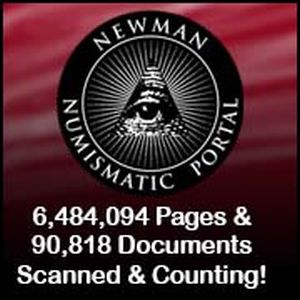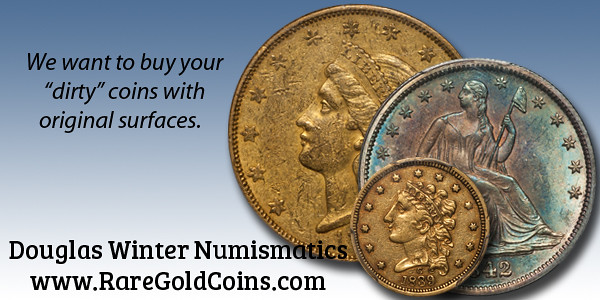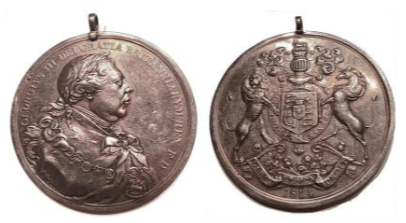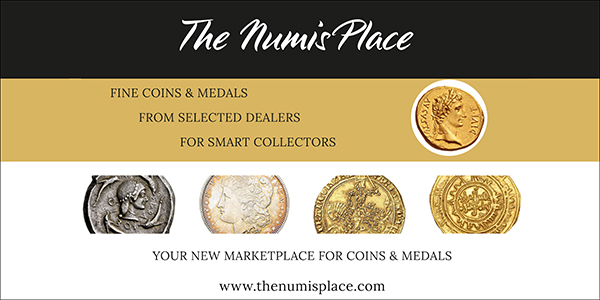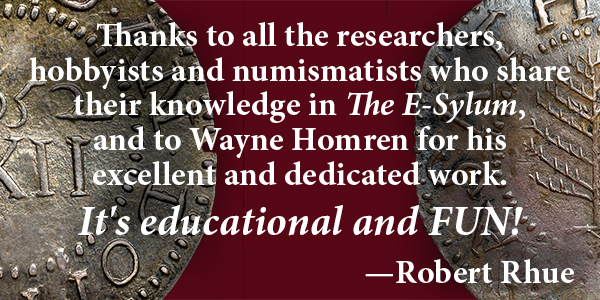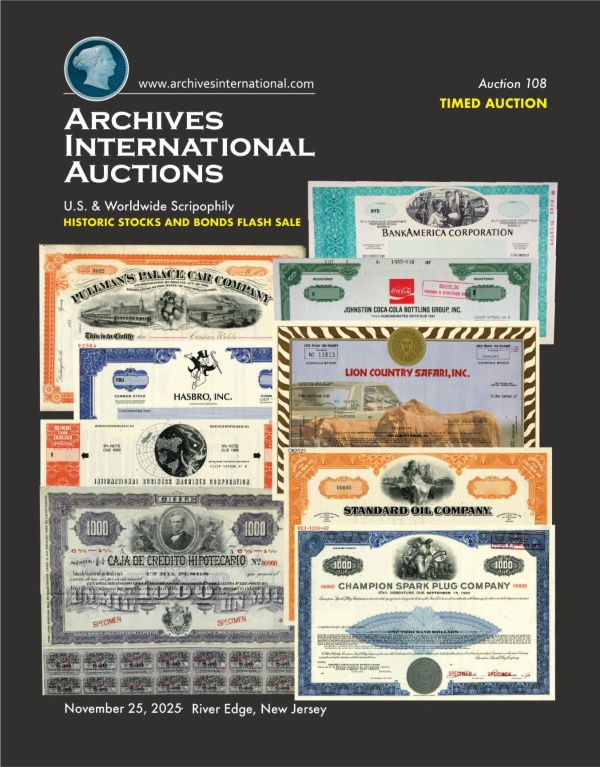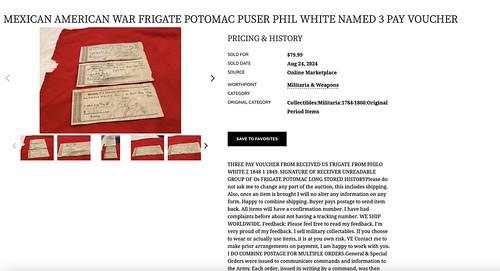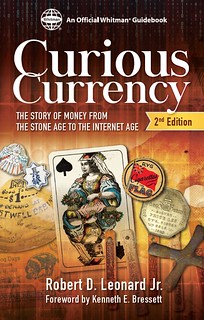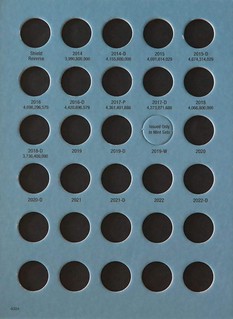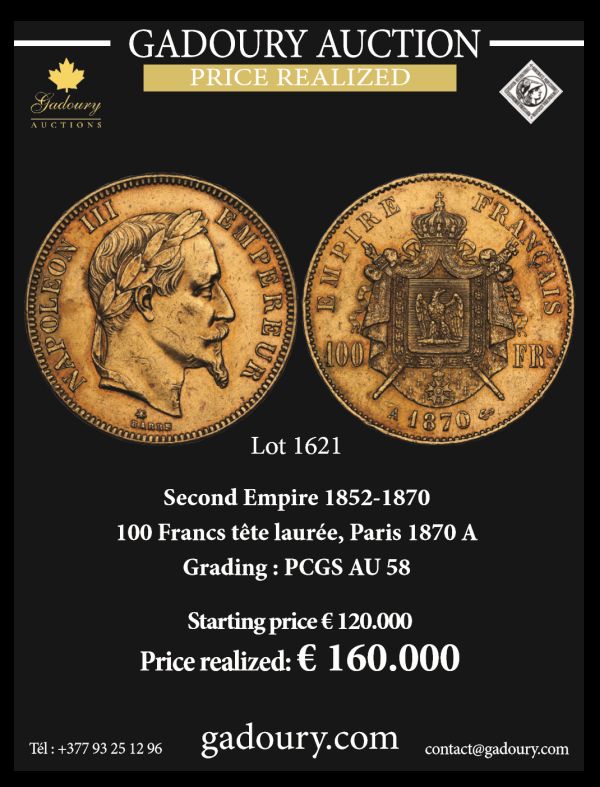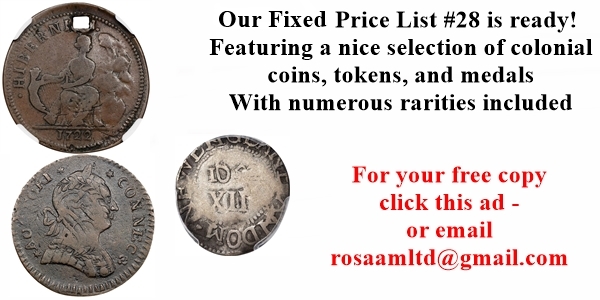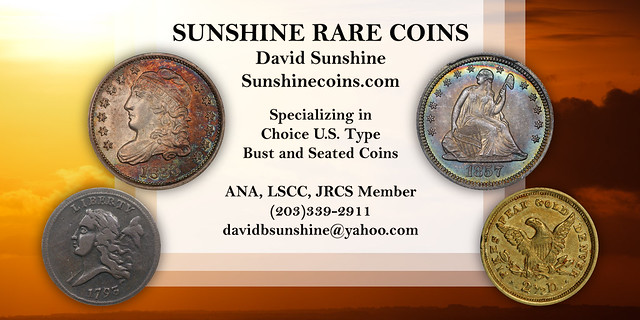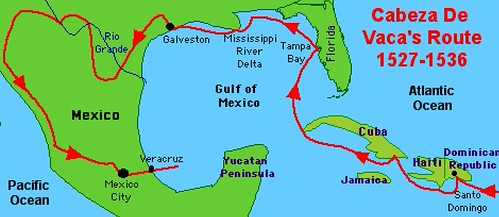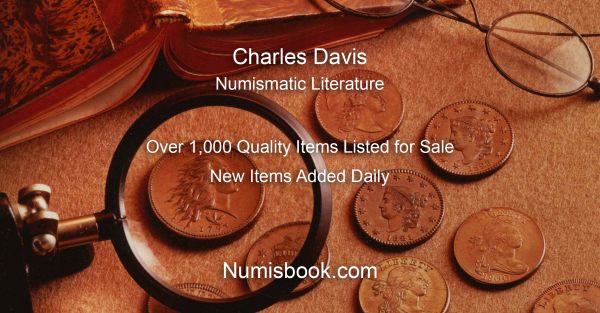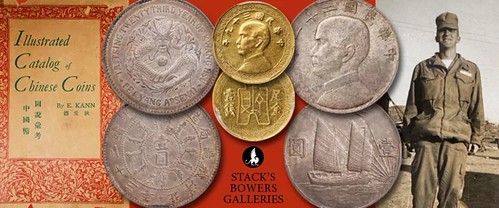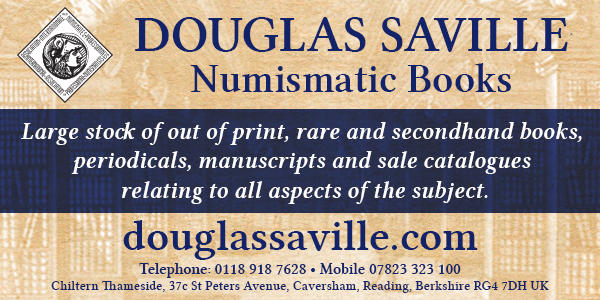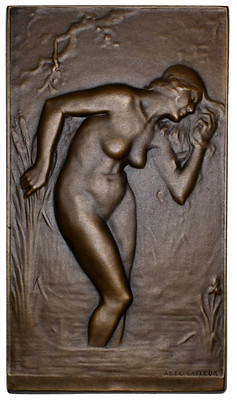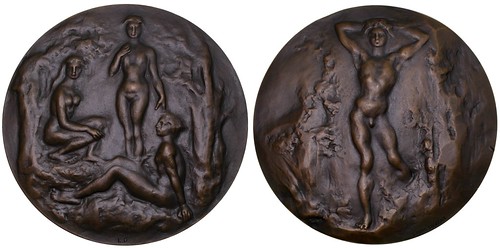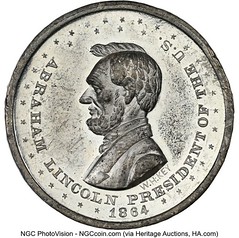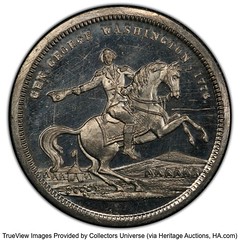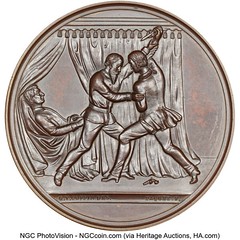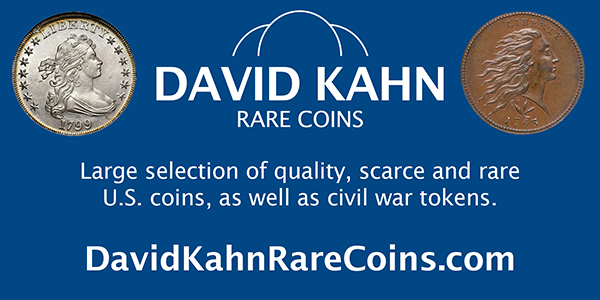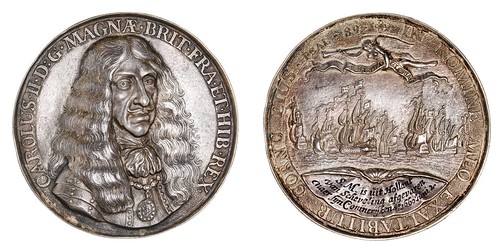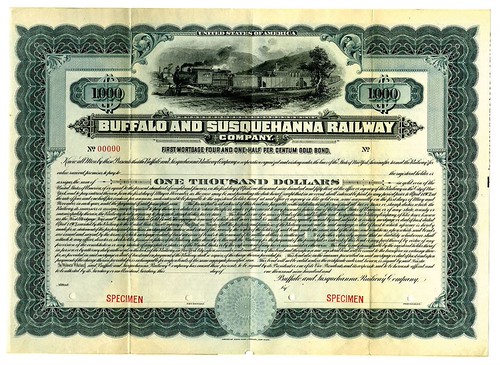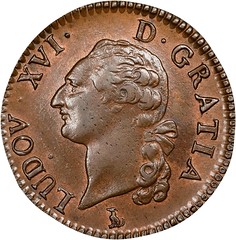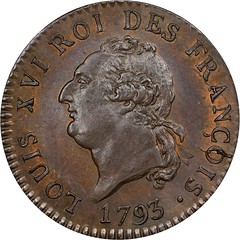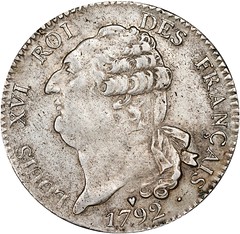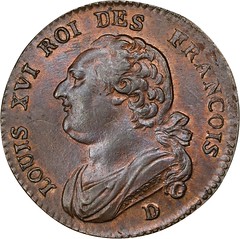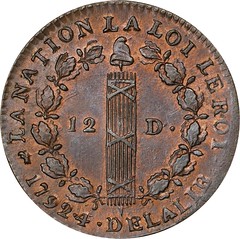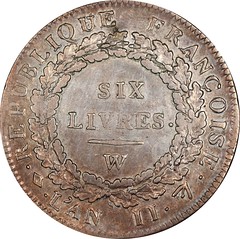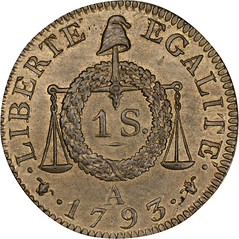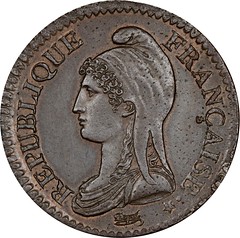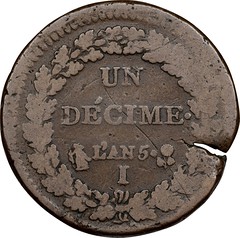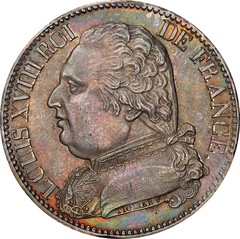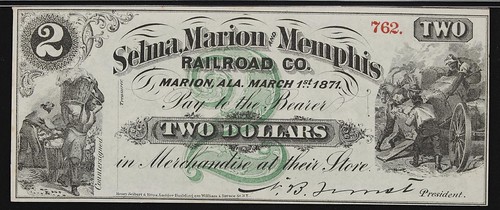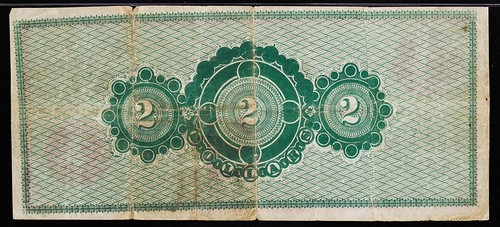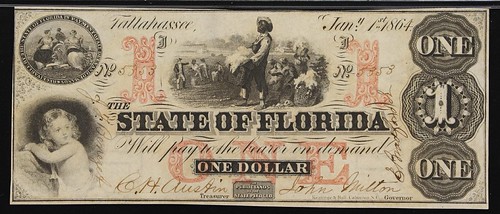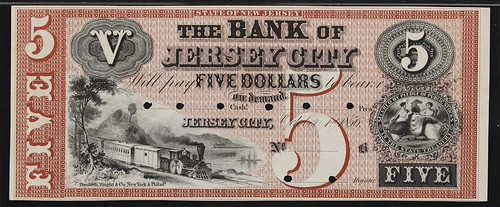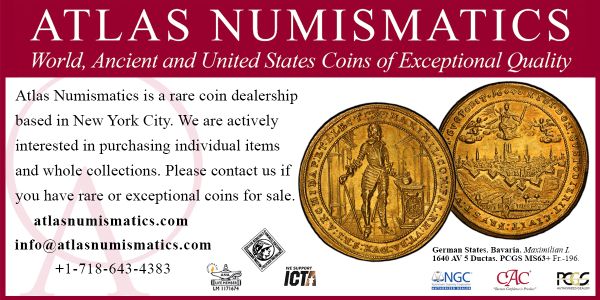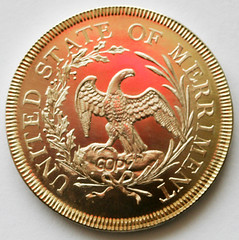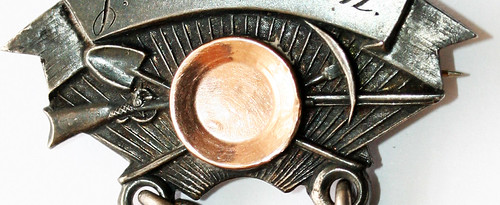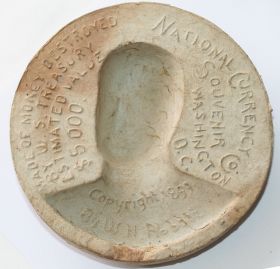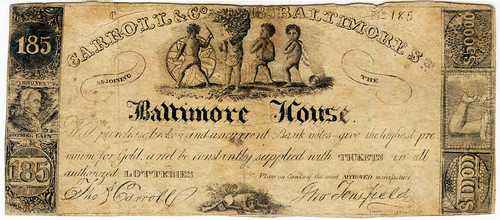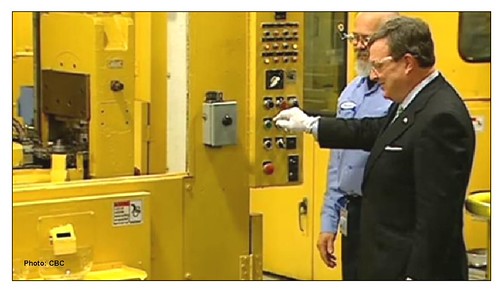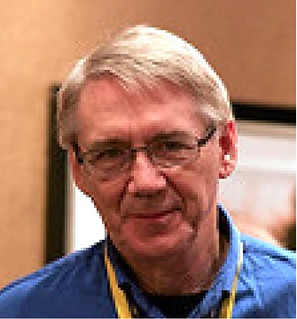
Visit our NBS Sponsors
About UsThe Numismatic Bibliomania Society is a non-profit association devoted to the study and enjoyment of numismatic literature. For more information please see our web site at coinbooks.org SubscriptionsThose wishing to become new E-Sylum subscribers can go to the following web page
Subscribe
MembershipThere is a membership application available on the web site Membership Application To join, print the application and return it with your check to the address printed on the application. Print/Digital membership is $40 to addresses in the U.S., and $60 elsewhere. A digital-only membership is available for $25. For those without web access, write to: Jeff Dickerson, Treasurer AsylumFor Asylum mailing address changes and other membership questions, contact Jeff at this email address: treasurer@coinbooks.org SubmissionsTo submit items for publication in The E-Sylum, write to the Editor at this address: whomren@gmail.com BUY THE BOOK BEFORE THE COINSale CalendarWatch here for updates! |
- WAYNE'S WORDS: THE E-SYLUM NOVEMBER 23, 2025
- STEVE FELLER (1951-2025)
- OCCASIONAL NUMISMATIC PAPERS DECEMBER 2025
- VIDEO: 2016 ERROR & VARIETY UPDATE
- ANS ANNOUNCES MOVE TO TOLEDO, OHIO
- NEW YORK TIMES COVERS ANS MOVE
- TOLEDO COVERAGE OF THE ANS MOVE
- NOTES FROM E-SYLUM READERS: NOVEMBER 23, 2025
- SOVEREIGN STORIES
- VOCABULARY TERM: SATIRICAL MEDAL
- OLD SPANISH TRAIL (1535-1935)
- THE JOHN M. STRAHAN, JR. COLLECTION
- FOUNDING SINCONA: JURG RICHTER
- NUMISMAGRAM MEDAL SELECTIONS: NOVEMBER 23, 2025
- HERITAGE: NOVEMBER 2025 TOKENS & MEDALS
- NOBLE NUMISMATICS NOVEMBER 2025 HIGHLIGHTS
- ARCHIVES INTERNATIONAL SALE 108
- STACK'S BOWERS: RICHARD MARGOLIS COLLECTION
- STACK'S BOWERS: DECEMBER 2025 OBSOLETE CURRENCY
- WAYNE'S NUMISMATIC DIARY: NOVEMBER 23, 2025
- PRINCETON'S COIN COLLECTION IN THE CLASSROOM
- FIRST COINS RECOVERED FROM THE SAN JOSE
- STACK'S BOWERS: THE LAST "OMEGA" CENTS
- COMMON SENSE AROUND COMMON CENTS
- THE LAST CANADIAN CENT
- WHAT NEXT FOR THE CENTS?
- UNCANCELLED MARTHA WASHINGTON PATTERN DIES
- ALTHEA GIBSON'S LEGACY
- WWII SPECIMEN UKRAINIAN NOTES
- VIETNAMESE CURRENCY EXHIBIT
- LOOSE CHANGE: NOVEMBER 23, 2025
- ABOUT THIS ISSUE: NOVEMBER 23, 2025
Content presented in The E-Sylum is not necessarily researched or independently fact-checked, and views expressed do not necessarily represent those of the Numismatic Bibliomania Society.
WAYNE'S WORDS: THE E-SYLUM NOVEMBER 23, 2025
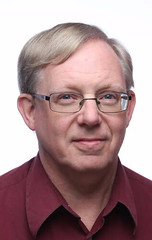 New subscribers this week include:
Simon Van Quigg and
Thomas Krawczyk.
Welcome aboard! We now have 6,756 subscribers.
New subscribers this week include:
Simon Van Quigg and
Thomas Krawczyk.
Welcome aboard! We now have 6,756 subscribers.
Thank you for reading The E-Sylum. If you enjoy it, please send me the email addresses of friends you think may enjoy it as well and I'll send them a subscription. Contact me at whomren@gmail.com anytime regarding your subscription, or questions, comments or suggestions about our content.
Sorry, no new books this week. We open with an obituary, updates from the Newman Numismatic Portal and the American Numismatic Society, notes from readers, and more.
Other topics this week include sovereigns, satirical medals, the Old Spanish Trail, John Strahan, Jürg Richter, fixed price and auction offerings, Princeton's coin collection, the first coins recovered from the San José, the last "Omega" cents, Martha Washington pattern dies, and Ukrainian and Vietnamese currency.
To learn more about WWII concentration camp money, fake Indian Chief medals, former Assay Commissioners, the purest description of money, the Kulture in Belgium medal, the expedition of Cabeza de Vaca, SINCONA, the holey dollar, the Richard Margolis Collection, the Society of Colorado Pioneers medal, three-coin Omega privy mark sets, Althea Gibson, and the ancient Roman goddess of the hinge, read on. Have a great week, everyone!
Wayne Homren
Editor, The E-Sylum
STEVE FELLER (1951-2025)
Len Augsburger submitted this obituary and remembrance of Steve Feller. Born January 12, 1951, he passed away this past Wednesday, November 19th, 2025 at the age of 74. So sorry to hear this news. -Editor
Steve Feller was born in Brooklyn in 1951. He was fiercely proud of New York and all things New York, including his attendance at a Brooklyn Dodgers game before the team moved to Los Angeles in 1958. Despite living most of his life in the Midwest, Steve's Brooklyn accent quickly betrayed his home-town loyalty. He was a collector from childhood. Harry Cynkus, a lifelong friend, recalled the two boys searching for cents and nickels in bank rolls to fill out their Lincoln and Jefferson sets. Feller received a Ph.D. in physics from Brown in 1979 and spent the remainder of his life as a professor at Coe College in Cedar Rapids, IA, where he was known simply as "Doc."
Steve was innately curious, a person who thought out loud and enjoyed matching wits on nearly any topic, not in the spirit of competition, unless the subject was the historical superiority of the New York Yankees, but with a humble ambition to see what new knowledge might develop from rigorous discussion.
 Steve's earliest numismatic works (co-written with his wife Barbara) are a pair of articles in The Numismatist (April 1981 and April 1982) related to WWII concentration camp money. Endnotes indicate that Steve had been interested in the subject since at least 1969. The topic was personal to Steve, whose grandmother ("Nana Pearl") escaped Poland before the war but lost most of her family. Steve gave a related presentation at the 1986 ANA convention in Milwaukee, speaking on "Money from the Lodz Ghetto." In 2007, Steve and his daughter Ray published a comprehensive guide to WWII camp money, Silent Witnesses: Civilian Camp Money of World War II.
Steve's earliest numismatic works (co-written with his wife Barbara) are a pair of articles in The Numismatist (April 1981 and April 1982) related to WWII concentration camp money. Endnotes indicate that Steve had been interested in the subject since at least 1969. The topic was personal to Steve, whose grandmother ("Nana Pearl") escaped Poland before the war but lost most of her family. Steve gave a related presentation at the 1986 ANA convention in Milwaukee, speaking on "Money from the Lodz Ghetto." In 2007, Steve and his daughter Ray published a comprehensive guide to WWII camp money, Silent Witnesses: Civilian Camp Money of World War II.
Over time Steve built perhaps the most significant collection of WWII camp money outside of the Charlton Meyer collection in the Houston Holocaust Museum. Not surprisingly, Steve authored the exhibit catalog for the Meyer collection, Questionable Issue: Currency of the Holocaust (2003). He spoke at the Meyer exhibit opening in Houston on August 28, 2003. Steve loaned portions of his own collection for an exhibit at Washington University in St. Louis in 2022, where he delivered a related presentation, with Ray Feller, in October of that year.
Steve wrote for any number of numismatic publications, and a complete bibliography could not be easily compiled. The IBNS Journal index notes 152 submissions. His work further appeared in The Numismatist and The Gobrecht Journal. In 1986 Steve shared, with Saul Needleman, the first-place Milton Fishgold literary award of the American Israel Numismatic Association. Steve, along with Ray Feller, was presented with the ANA President's Award by Gary E. Lewis in July, 2005. This was not Steve's first such award, having also been so recognized in June 1999. Steve and Ray were named Numismatic Ambassadors at the January 2018 FUN convention. The two were faithful attenders of the annual MPC Fest in Port Clinton, OH. Steve was a member of numerous numismatic organizations, including AINA, ANA, IBNS (he was editor of the IBNS Journal from 1990-2007), LSCC, NLG, SPMC, Carson City Collectors Club of America, Cedar Rapids Coin Club, Chicago Coin Club, and no doubt others.
I met Steve only in recent years, when he drove from Cedar Rapids to Washington University in St. Louis to loan us material for exhibit. Only when I grasped the significance of the collection did I understand why the material had to be hand-carried. Steve took"never again" personally and felt a responsibility to act accordingly. That was only a part of who he was, and his family, friends, and students will speak to his personal and professional impact for a long time.

Steve Feller, Clifford Mishler, and Ray Feller at the January 2018 FUN convention,
receiving Numismatic Ambassador awards
Link to Steve Feller obituary:
https://www.thegazette.com/obituaries/steve-doc-feller/
Link to Steve Feller memorial service video at Coe College, November 21, 2025:
https://www.youtube.com/live/H9JhzN0yypU?si=ydQqdoSebjUwnQ4b
Link to Steve Feller numismatic presentations on Newman Portal:
https://archive.org/details/newmannumismatic?tab=collection&query=steve+feller&and%5B%5D=mediatype%3A%22movies%22
Steve was a frequent contributor to The E-Sylum, often offering book reviews and research notes on featured numismatic items. I got to know him and his daughter Ray through Len, and looked forward to meeting up with them at ANA conventions. Steve was a delightful conversationalist with experience and connections far beyond the numismatic world. He will be greatly missed. -Editor
To read the earlier E-Sylum article, see:
BOOK ANNOUNCEMENT: SILENT WITNESS - WORLD WAR II CIVILIAN CAMP MONEY
(https://www.coinbooks.org/esylum_v10n08a03.html)
STEVE FELLER: LINCOLN CENTS BY THE NUMBERS
(https://www.coinbooks.org/esylum_v13n09a08.html)
BOOK REVIEW: ALLIED MILITARY MARKS IN GERMANY
(https://www.coinbooks.org/v24/esylum_v24n37a07.html)
MORE ON THE PIONEER BASE BALL CLUB
(https://www.coinbooks.org/v28/esylum_v28n23a07.html)
FULBRIGHT SCHOLARS IN NUMISMATICS
(https://www.coinbooks.org/v28/esylum_v28n37a15.html)
NOTES FROM E-SYLUM READERS: AUGUST 17, 2025 : Steve Feller Visits the Higgins Museum
(https://www.coinbooks.org/v28/esylum_v28n33a14.html)
THE BOOK BAZARRE
OCCASIONAL NUMISMATIC PAPERS DECEMBER 2025
The latest addition to the Newman Numismatic Portal is the December 2025 issue of Occasional Numismatic Papers. Project Coordinator Len Augsburger provided the following report. -Editor
Occasional Numismatic Papers on NNP
Published and edited by Chris Faulkner and Jacob Lipson, the Occasional Numismatic Papers series gathers well-researched works on Canadian numismatics. The recently released December 2025 issue includes articles by Jeff Ogborne, Markus Molenda, and Jacob Lipson, in addition to related notes. Lipson's piece questions the authenticity of a large-size George III Indian Chief medal. The example is underweight and failed composition testing. A piece of chipped plating betrayed brassy color underneath, obviously incorrectly for a medal ostensibly struck in silver.
Link to Occasional Numismatic Papers on NNP:
https://nnp.wustl.edu/library/publisherdetail/545751
VIDEO: 2016 ERROR & VARIETY UPDATE
The David Lisot Video Library on the Newman Numismatic Portal can be found at:
https://nnp.wustl.edu/library/multimediadetail/522852
We highlight one of his videos each week in The E-Sylum. Here's one from 2016 with Fred Weinberg and B.J. Neff speaking about errors and varieties. -Editor
Mr. Weinberg is considered America's leading error coin expert. Mr. Neff has several decades of experience as a variety researcher. Speaker: Fred Weinberg & B.J. Neff.
To watch the complete video, see:
Error & Variety Update 2016
(https://www.youtube.com/watch?v=1rEgLs4tYBM)
Error & Variety Update 2016
(https://nnp.wustl.edu/library/book/549004)
ANS ANNOUNCES MOVE TO TOLEDO, OHIO
This press release announces a blockbuster event for the venerable American Numismatic Society - a move from its New York birthplace and home since 1858 to a new location in Toledo, OH. -Editor
 Building on its nearly 170-year history of preserving the most comprehensive collection of coins, art medals, and other numismatic and monetary objects in the U.S., the American Numismatic Society will expand its reach, deepen its commitment to research and scholarship, and continue to educate and inspire new generations through the rich stories told by coins and money.
Building on its nearly 170-year history of preserving the most comprehensive collection of coins, art medals, and other numismatic and monetary objects in the U.S., the American Numismatic Society will expand its reach, deepen its commitment to research and scholarship, and continue to educate and inspire new generations through the rich stories told by coins and money.
The American Numismatic Society (ANS)—a nearly 170-year-old organization dedicated to the public appreciation and research of coins, currency, and medals and holding the most comprehensive collection of numismatic objects in the United States—today announced its strategic relocation from its current leased location at 75 Varick Street in New York City to Toledo, Ohio, where it will take up residence on the campus of the Toledo Museum of Art (TMA).
This major relocation, taking place in the first half of 2028, will enable the ANS to better serve its American and international audiences while developing a strong relationship with the local community in the former major industrial city now undergoing a cultural revival.
"The American Numismatic Society's move to Toledo marks a transformative new chapter in our long history," says Dr. Ute Wartenberg Kagan, Sydney F. Martin Executive Director, The American Numismatic Society. "Partnering with the renowned Toledo Museum of Art, we will create innovative museum displays that highlight our remarkable collection of coins and medals. We are eager to reach new audiences and develop an affordable, state-of-the-art museum space that supports our mission of research, education, and public engagement. We also anticipate strengthening our academic partnerships with local universities, making Toledo a vibrant hub for numismatic study and research."
Founded in 1858 by a group of passionate collectors in New York City, the ANS has grown from modest beginnings as a coin club into a prominent museum and research institution. Its extensive collection—ranking among the top four of its kind worldwide—includes nearly 800,000 coins, monetary objects, art medals, military orders, and decorations, which collectively serve as a gateway to history, providing profound insight into the cultural, economic, political, and art of societies around the world and across the centuries.
Home to the best numismatic library anywhere, the ANS is also a major publisher of books on coins and medals, while leading the way in the digital transformation of numismatics by developing open-access online tools and databases that connect coins and currency globally to broader historical and humanities research.
A four-story Art Deco building adjacent to and acquired from TMA will serve as the ANS's new home, where a dedicated museum hall and flexible gallery spaces will enable the organization to host world-class exhibitions and to showcase a wider array of its extraordinary treasures, many of which have never been publicly displayed.
Offering more space to properly care for, study, and display its ever-growing collections—of which more than 100,000 numismatic objects were added in the past twenty years alone, including the extensive archives of the Medallic Art Company acquired in 2017—the ANS's Toledo building will house a library, an auditorium, and an Education Center.
Together these vastly expanded resources will serve to cement the organization's position as a leading research center, while reaching a wider audience. As numismatics is one of the largest fields of collecting interest, with approximately 150 million enthusiasts in the U.S. alone, the ANS will become an unmatched destination not just for local audiences and the 300,000-plus visitors TMA welcomes to its campus each year, but also for international travelers, with Detroit Metro Airport less than an hour away.
Through a new institutional partnership, objects from the ANS collection will be integrated into several of TMA's permanent collection galleries, which are currently undergoing a major chronological reinstallation to be unveiled in late 2027.
TMA's permanent collection exhibits will be conceptually and materially enhanced by these additions from the ANS, providing unique insight into and a direct connection with each historical era since coins represent tangible, everyday reflections of events, social norms, and economic behaviors.
"We could not be more excited as a Museum or as a community to welcome the American Numismatic Society to the city as our neighbor," comments Adam Levine, TMA's Edward Drummond and Florence Scott Libbey President, Director and CEO."TMA's collection spans human history but is distinguished by a commitment to presenting works of only outstanding quality, which makes ANS the perfect partner to enrich our collection displays with the integration of numismatic items while enhancing both the art historical experience for all visitors to our shared campus and research opportunities for scholars."
In addition to this close partnership with TMA, the ANS intends to partner with other local organizations and venues, furthering the organization's ability to mount interdisciplinary exhibitions, conduct new research, and host events that the current facilities in New York City cannot support, such as major academic conferences and hands-on programs that demonstrate how money functions and help attendees develop practical financial skills for everyday life.
ABOUT THE AMERICAN NUMISMATIC SOCIETY
Founded in 1858, the American Numismatic Society is dedicated to the study and appreciation of numismatics and has assembled a permanent collection of more than 800,000 coins, monetary objects, medals, and other related items dating back to 2000 BCE. The specialized library contains approximately 100,000 books, documents, and artifacts that are among the finest of such resources. Together, they comprise one of the most extensive numismatic holdings in the world. The Society is also a global leader and innovator in the development of digital numismatic resources and is one of the largest publishers of scholarly numismatic research, enjoyed by its members, fellows, and the public at large. Visit the ANS at numismatics.org.
ABOUT TOLEDO MUSEUM OF ART
Recently named the 2025 Best Art Museum in the USA TODAY 10 Best Readers' Choice Awards, the Toledo Museum of Art (TMA) is a beloved cultural institution in Toledo, Ohio, and a global leader in the museum field. Established in 1901, its renowned collection features over 25,000 works, ranging from antiquity to contemporary art, and includes one of the finest collections of glass in the world. Situated on a 40-acre campus, TMA integrates art into people's lives through its world-class collection, engaging exhibitions, robust educational programs, and community outreach.
Admission to TMA is always free, inviting all to explore its galleries. The museum is open Wednesday, Thursday and Sunday from 11 a.m. to 5 p.m. and on Friday and Saturday from 11 a.m. to 8 p.m. It is closed on Monday, Tuesday and select holidays. TMA is located at 2445 Monroe St., just one block off I-75, with exit signs posted for easy access. For more information, call 419-255-8000 or visit toledomuseum.org.
Wow - good luck with the move and new home! This was a hard but long-considered and well thought-out decision. The spacious and far more affordable location will enable the expansion of important programs and be more accessible to a new audience. See the following article for coverage from The New York Times. -Editor
NEW YORK TIMES COVERS ANS MOVE
The New York Times published an article about the ANS move to Toledo, and it goes into more of the history and background of this decision. Here's an excerpt - see the complete article online. -Editor
 On the 11th floor of a downtown Manhattan building, just around the corner from the Holland Tunnel, sits one of the world's finest collections of coins. Stored behind a series of locked doors in a massive, climate-controlled vault, the coins tell the story of civilization, from antiquity to today.
On the 11th floor of a downtown Manhattan building, just around the corner from the Holland Tunnel, sits one of the world's finest collections of coins. Stored behind a series of locked doors in a massive, climate-controlled vault, the coins tell the story of civilization, from antiquity to today.
A Sumerian clay tablet from about 2000 B.C.E. Early Chinese forms of money shaped like miniature tools. A silver French penny from the age of Charlemagne. A medal given by the Lincoln administration to a Native American chief, pierced by a bullet. More than 800,000 other telltale coins, medals and objects of wonder.
But apart from scholars, members and the occasional enthusiast, almost no one sees this treasure, which is one reason its guardian, the American Numismatic Society, is leaving the city where it was founded in the mid-19th century — and moving to Toledo, Ohio.
 The society announced today that it will be making a"strategic" relocation to an Art Deco building on the spacious campus of the Toledo Museum of Art. The $20 million plan, to be completed in 2028, would make possible its long-harbored vision of a state-of-the-art money museum, a dream that has proved elusive in New York.
The society announced today that it will be making a"strategic" relocation to an Art Deco building on the spacious campus of the Toledo Museum of Art. The $20 million plan, to be completed in 2028, would make possible its long-harbored vision of a state-of-the-art money museum, a dream that has proved elusive in New York.
"One of our members said that this will mean a terrible loss to New York City," the society's executive director, Ute Wartenberg Kagan, said."But if no one uses it, what's the loss?"
Wartenberg Kagan, a scholar of ancient Greek coinage, left the British Museum in 1998 to join the American Numismatic Society and someday establish a proper money museum where one belonged, in the city of Wall Street. But exorbitant costs and space constraints conspired against those plans, as did an apparent indifference to the charms of numismatics.
So: Hello, Toledo!
Wartenberg Kagan said that she and several other colleagues are eager to make the 560-mile move west, where the society has already bought the building that will house its collection as well as a library, auditorium and education center. The population of the Toledo metropolitan area is about 650,000, less than one-tenth that of New York City, but there are many buts.
The cost of living is lower. The campus has plenty of space to accommodate the school buses that never pulled up to the current location because there was nowhere to park. And there is the opportunity to work in concert with the museum, integrating collections to produce dynamic exhibits for an engaged community.
"We're not just buying real estate," Wartenberg Kagan said."We're buying a relationship."
A year could be lost in the vault of the American Numismatic Society.
But the society's leased space is too expensive ($1.8 million a year, including taxes), too small to accommodate its ever-growing holdings and not conducive to public engagement. A few years ago, a travel guide included the society among its list of free attractions — open by appointment and closed on weekends — in Lower Manhattan. Even then, only a half-dozen or so tourists might wander in every week.
"This is both a big and a small place," Wartenberg Kagan said."That's one of its problems."
For the last several years, the society — which has 1,400 members, including 265 outside the United States — has searched for more suitable quarters. Plans to move to the University of Chicago fell apart, as did those to move to the University of Pennsylvania, Long Island City in Queens and a warehouse in Fall River, Mass.
Then came a bit of numismatic serendipity. It just so happened that Adam M. Levine, the president and director of the Toledo Museum of Art, had spent the summer of 2009 at the American Numismatics Society, studying the iconography of Justinian II coinage. He contacted Wartenberg Kagan, whom he knew, and suggested that she consider Toledo, where he just happened to know of a four-story building on the museum's 37-acre campus that would soon become available.
A dubious Wartenberg Kagan visited Toledo — and came away persuaded. It checked every box for the society's trustees, including a supportive, good-sized city, reasonable housing costs and proximity to major research facilities.
Other staff members also made the trip to Toledo and liked what they saw. About half of the 17-member staff will be making the move, including Wartenberg Kagan and van Alfen.
"They will be welcomed with open arms," Levine predicted."And they'll have more visitors in their first year than they've had in the last five."
"Probably 10 years," Wartenberg Kagan added.
To read the complete article, see:
After 167 Years in New York, a Priceless Coin Collection Heads to Toledo
(https://www.nytimes.com/2025/11/20/arts/design/american-numismatic-society-coins-toledo.html)
TOLEDO COVERAGE OF THE ANS MOVE
A local Toledo news station covered the news as well. -Editor
The American Numismatic Society - an organization dedicated to the research and preservation of coins, currency and medals, will relocate its location from the Big Apple to the Glass City.
In a piece on Numismatic News, the American Numismatic Society wrote on Thursday that it would be moving itself and its collection from New York City to Toledo in the first half of 2028. The nearly 170-year-old organization announced it would be specifically moving to a location on the Toledo Museum of Art's campus, where a dedicated museum hall and gallery spaces will allow the organization to host exhibitions, as well as showcase its archives. The society said some of its objects will be on public display for the first time ever.
Its building, located at 1828 Parkwood Ave., will feature a library, auditorium and education center, the society said. It will join TMA following the art museum's planned reinstallation project, which is set for completion in 2027.
The society described its move to Toledo as one that will allow for more space to care for, study and display its collections. Additionally, it described Toledo as a "community in the former major industrial city now undergoing a cultural revival," a movement it said it wants to contribute to through programming and research.
ANS also said in addition to its partnership with TMA, it plans to partner with other local organizations and venues for further study, public engagement, academic conferences and more.
The society holds the most comprehensive collection of numismatic objects in the United States, it said. This includes nearly 800,000 coins, monetary objects, art medals and more from around the world and throughout history.
WTOL 11 reached out to the Toledo Museum of Art for comment. A spokesperson provided the following:
"We could not be more excited as a Museum or as a community to welcome the American Numismatic Society to the city as our neighbor," said Toledo Museum of Art Director Adam Levine."ANS is the perfect partner to enrich our collection displays with the integration of superlative works of monetary history."
To read the complete article, see:
American Numismatic Society to leave NYC, relocate to Toledo Museum of Art campus
(https://www.wtol.com/article/news/local/american-numismatic-society-to-relocate-to-toledo-from-nyc-new-york-city-coin-collection-research/512-75587082-64ed-45c9-82a9-480dadaa33dc)
To watch the video, see:
American Numismatic Society to leave NYC, relocate to Toledo Museum of Art campus
(https://www.youtube.com/watch?v=D-AqWHOTKAo)
To read other coverage, see:
American Numismatic Society announces move from N.Y.C. to Toledo
(https://www.toledoblade.com/local/city/2025/11/20/american-numismatic-society-announces-move-from-n-y-c-to-toledo/stories/20251120118)
American Numismatic Society Relocates to Toledo Museum of Art Campus
(https://www.numismaticnews.net/ana-relocates-to-toledo-museum-of-art-campus)
NOTES FROM E-SYLUM READERS: NOVEMBER 23, 2025
Double Large Cent Birth Years Token?
"Plausible theory but you could also wager that it is the birth years of children."
Another good possibility! I hadn't considered that option.
I doubt we'll ever know why this was done, but these are interesting theories. -Editor
To read the earlier E-Sylum article, see:
NOTES FROM E-SYLUM READERS: NOVEMBER 16, 2025 :
Double Large Cent Love Token?
(https://www.coinbooks.org/v28/esylum_v28n46a15.html)
On Discontinued Denominations
Paul Hybert writes:
"Regarding the minting of the last US one-cent coin: one sourced article mentions that this is the first discontinuation of a circulating denomination since the half-cent in 1857. Oh? What about all the gold denominations? What about the silver 20-cent piece? What about the 3-cent pieces in various alloys? What about the 2-cent piece in some copper-based alloy? All after 1857."
Well, if they meant the last time the SMALLEST denomination was discontinued, they're right. But it wasn't stated that way in the article you saw. Yes, there have been several discontinued denominations since 1857. The article you saw may have had that point rephrased by the reporter. The Wall Street Journal article we quoted said only that U.S. Treasurer Brandon Beach stated "The last equivalent event... was the end of the half-cent in 1857." That doesn't mention denominations and COULD have been about discontinuing the smallest denomination. -Editor
To read the earlier E-Sylum article, see:
THE U.S. MINTS ITS FINAL CENTS
(https://www.coinbooks.org/v28/esylum_v28n46a12.html)
Former Assay Commissioners
Frank Robinson writes:
 "A shock to see Tom Klunzinger's name in your latest "Who's Dead" report. We were both on the 1972 Assay Commission — the only two youngsters there (he was 27, I was 24), and we stayed in touch since. Over the years he bought coins from me and sold me batches. I knew he was a playwright, but didn't realize what a colorful life he'd had. Though I did know he was a fizzy character. I called him "Zinger."
"A shock to see Tom Klunzinger's name in your latest "Who's Dead" report. We were both on the 1972 Assay Commission — the only two youngsters there (he was 27, I was 24), and we stayed in touch since. Over the years he bought coins from me and sold me batches. I knew he was a playwright, but didn't realize what a colorful life he'd had. Though I did know he was a fizzy character. I called him "Zinger."
Not many former Assay Commissioners left now. David Ganz was actually younger than me, but he passed away this year. I believe Paul Whitnah is about a year older. Arthur Fitts rather more. Will I wind up the last survivor?!"
A shrinking club, for sure. Such a shame that the Assay Commission was shut down. Three cheers for the UK's Trial of the Pyx. -Editor
To read the earlier E-Sylum article, see:
THOMAS E. KLUNZINGER (1944-2025)
(https://www.coinbooks.org/v28/esylum_v28n46a09.html)
More on the U.S. Frigate Potomac Purser's Check
"Here's a group lot of 3 that brought $80 on eBay in 2024 (though Worthpoint often lists things as "sold" that were merely buy it now listings that never sold)."
Thanks. So there's one pricepoint - three for $80. And rather than checks, these are more properly termed "receipts." Still an interesting item, if not rare. -Editor
To read the earlier E-Sylum article, see:
NOTES FROM E-SYLUM READERS: NOVEMBER 16, 2025 :
U.S. Frigate Potomac Purser's Check
(https://www.coinbooks.org/v28/esylum_v28n46a15.html)
The Purest Description of Money
Bob Leonard submitted these comments about a passage in last week's article about the new "History of Money" book. -Editor
In the November 16 E-Sylum you wrote "That paragraph about money and trust is the purest description I've ever seen for money." The paragraph in question is:
That trust is essential to the system is a key point for McWilliams. Today, if you hand me $10, I'm trusting many things at once: first, that this piece of printed paper has a meaning, a meaning that will be understood by a shopkeeper when I try to exchange it later that day for a coffee; second, that the government which issued this bill will back it; third, that you are not a forger, and the bill you give me is genuine. Our entire relationship with money is based on trust.
I covered this same point in my definition of money in the first chapter of Curious Currency:
In simplest terms, then, money is"anything used to make a payment that the recipient trusts can be reused to make another payment."
I give examples of reasons for trust, etc., but I think that this definition is even purer than "the purest."
I agree! Thanks, Bob - that is even more concise. -Editor
To read the earlier E-Sylum articles, see:
NEW BOOK: CURIOUS CURRENCY, SECOND EDITION
(https://www.coinbooks.org/v22/esylum_v22n12a02.html)
BOOK REVIEW: THE HISTORY OF MONEY
(https://www.coinbooks.org/v28/esylum_v28n46a06.html)
The Last Edition of the Whitman Cent Folder?
"With the last cent now having been struck, it is safe to say Whitman will soon be issuing its final edition Lincoln Cent folder as well. It recently took four folders to complete the Lincoln series, with the last stopping at 2022. With the cent now history, its safe to say there should be enough blank spaces to complete the series within the last volume. I've always considered Whitman Lincoln Cent folders the gateway to numismatics, especially for younger collectors.
"I can remember several variations and editions from my collecting past. Aside from the recent four volume set, there were separate volumes for the Memorial series. Earlier folders were simply titled "Lincoln Head Cents" and divided into multiple folders as well. I remember one year just before Christmas when I purchased a since long out of print "one-a-year" folder. I was about nine years old, and knew enough about the series that I could never fill the 1909-S VDB slot with my current allowance, so why torture myself. Well, mom caught me with it and made me return it, saying I'd probably get one for Christmas. I did, only to discover she had bought me the harder to fill P-D-S folder. Needless to say I was peeved. I didn't want anyone to tell me what to collect and how to collect it! The best thing about Whitman was they always gave you choices. (You can find all of these, and much more, by looking through David Lange's landmark Coin Collecting Albums Volume Three: Whitman Publishing Company.)"
I reached out to the company for comment. -Editor
Whitman Brands Chief Operating Officer Michael Pfeiffer writes:
"With the final strike of the circulating penny, we'll be closing out any remaining open volumes with 2025 issues across all Lincoln Cent album and folder collections—from the nostalgic Whitman folders to our new, elevated Prestige albums—as inventory is naturally replenished."
Is Andrew Zabriskie the Buyer "Highland"?
"Regarding Saul Teichman's question, I am not able to state this with certainty, but my suspicion is that Andrew Zabriskie is "Highland" in the 1894 Wood catalog by the Chapmans. I compared other rare pieces from the Wood collection catalog indicated to have been won by "Highland" and I found several of the same (along with a Chowder Club medal at Zabriskie lot 117) that appear in the 1909 Zabriskie sale."
Saul writes:
"It is certainly possible.
"If that is the case, then the 1884 Wood coin is apparently the Boyd-Ford coin."
Thanks! Julia compiled this comparison using the Newman Numismatic Portal. -Editor
To read the earlier E-Sylum article, see:
NOTES FROM E-SYLUM READERS: NOVEMBER 16, 2025 : Query: Isaac Wood Sale Chowder Market Club Token Buyer
(https://www.coinbooks.org/v28/esylum_v28n46a15.html)
Combating Coin Show Marketing Spam
Dick Hanscom writes:
"I get emails from various addresses, wanting me to make reservations for coin shows through them,
Good question. Anyone? -Editor
SOVEREIGN STORIES
Zach Filis submitted these fun facts about the Sovereign inspired by the "Birth of the Sovereign" article in last week's E-Sylum. Thanks! -Editor
While the birth of the sovereign dates back to 1489 and NGSA presents a very nice summary of it for the piece they are offering, I thought I would provide some additional information about the sovereign in general. The sovereign's history and longevity is significant. Known as the chief coin of the world, especially during the height of the British empire, it is amazing that they are still being minted today. The modern, milled version, sovereign began in 1817 under the rule of King George III.
The sovereign was circulated throughout the world having mints in England, Australia, Canada, India and South Africa. London stopped issuing the sovereign for circulation in 1916/1917 to pay for their war debts and the sovereign became more or less bullion in England at that time. The sovereign however, continued to be minted for circulation and used in every day commerce through the early 1930s in Australia and South Africa.
Did you know that there would not be a Smithsonian Institution without the sovereign? James Smithson, an Englishman, who never visited the United States gifted 105 bags of sovereigns containing 104,960 freshly minted 1838 sovereigns to the United States to"increase and diffusion of knowledge". The United States insisted on new and not worn sovereigns that may have experienced gold loss from wear. Queen Victoria became the British monarch in 1837 and the 1838 sovereign was the first year coinage bearing her portrait.
Because the sovereign was not legal tender in the United States, the sovereigns were melted down and recoined into America $10 gold pieces. It is almost certain that any 1838 gold eagle that you may find, began its life as a sovereign.
Sovereigns were found in very limited quantities in and around the USS Central America shipwreck. A sovereign was found in the purser's safe and a few more were found in one of the coin piles which included a recently minted 1855 and 1856 Australian sovereign.
Jefferson Davis, the President of the southern states during the civil war allegedly fled from Richmond south with a considerable amount of gold and silver. Included was $25,000 worth of sovereigns. Micajah Clark, Captain in the Confederate army, may have used the sovereigns to pay his men with sovereigns after transporting the gold and silver to Florida.
Sovereigns were issued to the Army Air Corps crews during World War II in case they were shot down behind enemy lines. The sovereigns were much more recognized throughout the world than any American coin at that time. These emergency escape kits were assembled by the Naval Air Command in Norfolk Virginia.
These are only a few examples of the interesting sovereign stories that can be found. I chose them because they are associated with events throughout the history of the United States. There are so many other significant and historic facts/stories about the sovereign and many books have been published about them. There are also many different ways that you can create a collection of them. The sovereign really deserves the name chief coin of the world.
To read the complete article, see:
THE BIRTH OF THE SOVEREIGN
(https://www.coinbooks.org/v28/esylum_v28n46a23.html
VOCABULARY TERM: SATIRICAL MEDAL
Here's another entry from Dick Johnson's Encyclopedia of Coin and Medal Terminology. -Editor
Satirical Medal. A medallic item whose theme is basically humorous, often cutting or critical much like an editorial cartoon. The undisputed master of satirical medals was German medalist Karl Goetz (pronounced gertz) who chose the cast medal as his favorite art form. Although he made patterns and dies, had medals struck, even had small items coined, he created over 700 different numismatic and medallic items by casting. It was his theme and style that was so intriguing.
Inspired by a current event Goetz would prepare a medallic design with a highly critical viewpoint. He was highly nationalistic (pro-Germany), disrespectful of authority (even critical of Hitler who he survived), offensive to alien countries and policies (anti-British and French), insulting to local authorities and national critics. In short he would have made an excellent editorial cartoonist had he not been a highly talented medalist. He handled the theme with bitting humor. It brought smiles to the viewer once his medallic concept was understood. His most famous work was the Sinking of the Lusitania Medal. Other German medalists imitated his work but never achieved quite the cutting edge of his satire.
In America, medalist and sculptor Paul Manship prepared a noted satirical medal, Kulture in Belgium Medal of 1918. It displayed Kaiser Wilhelm II with a necklace of skulls (deaths of civilians) on the obverse, with a German soldier carrying off a squirming mother, her dead child lies on the ground. It was as if Manship met Goetz head on with his own technique. Other satirical medals have been issued, including a series issued in the 1970s by numismatist Robert W. Julian. Satirical medals cut right to the point and employ symbolism to its greatest medallic degree.
To read the complete entry on the Newman Numismatic Portal, see:
Satirical Medal
(https://nnp.wustl.edu/library/dictionarydetail/516700)
To read earlier E-Sylum articles, see:
NEW BOOK: THE MEDALS OF THE LUSITANIA
(https://www.coinbooks.org/esylum_v15n36a02.html)
MORE ON MANSHIP'S KULTUR IN BELGIUM MEDAL
(https://www.coinbooks.org/esylum_v15n13a09.html)
OLD SPANISH TRAIL (1535-1935)
E-Sylum Feature Writer and American Numismatic Biographies author Pete Smith submitted this article on the Old Spanish Trail and the Old Spanish Trail commemorative half dollar designed and marketed by L. W. Hoffecker. Thanks! -Editor
My research into the story of L. W. Hoffecker got me interested in the Old Spanish Trail. I think that story is also worth telling.
 The Encyclopedia of United States Silver & Gold Commemorative Coins 1892-1954 was written
by Anthony Swiatek and Walter Breen and published in 1981. The book frequently mentions
abuses in the commemorative coin program. In discussing the Old Spanish Trail half, the book
states,
The Encyclopedia of United States Silver & Gold Commemorative Coins 1892-1954 was written
by Anthony Swiatek and Walter Breen and published in 1981. The book frequently mentions
abuses in the commemorative coin program. In discussing the Old Spanish Trail half, the book
states,
"For once, no venality appears to have been involved, only praise. No scandal attached itself to Hoffecker despite his being a well known coin collector. Collectors did not receive favored-party treatment in distribution of the coins; speculators got none of them."
Hoffecker promoted the legislation that authorized the coin. The Act was passed on June 5, 1935. The relevant part of the legislation stated,
"That to indicate the interest of the Government of the United States of America in commemorating the four hundredth anniversary of the Expedition of Cabeza de Vaca and the opening of the Old Spanish Trail, there shall be coined by the Director of the Mint silver 50-cent pieces to the number of not more than ten thousand…"
Hoffecker designed the coin. The reverse has a map showing the route of de Vaca and passing through the cities of St. Augustine, Jacksonville and Tallahassee in Florida; Mobile, Alabama; New Orleans, Louisiana; Galveston, San Antonio and on to El Paso. Texas. None of those existed in 1535.
On June 17, 1527, an expedition of five ships left Spain with 600 soldiers and colonists. The leader was Panfilo de Narvaez. Alvar N?nez Cabeza de Vaca was treasurer of the expedition and second in command.
The expedition stopped at what is now The Dominican Republic and spent the winter of 1527-28 in Cuba. On April 15, 1828, they landed on Florida, possibly near Tampa Bay. After wandering through the swamps in an unsuccessful quest for gold, they returned to the sea to travel west. Narvaez was lost at sea somewhere between the Mississippi delta and Galveston.
Cabeza de Vaca was blown ashore with two ships and eighty men near Galveston Island, Texas. For four years, Cabeza de Vaca lived among the indigenous people and survived by trading with the local tribes.
With only four survivors from the original crew, they walked across southern Texas. They crossed into what is now Mexico about seventy-five miles downstream from what would become El Paso. They walked barefoot across northern Mexico and down the Gulf of California. Eventually they made contact with other Spaniards in Mexico City and arranged for transportation back to Spain in 1537.
When he returned to Spain, he wrote his memoirs of his travels and of the tribes he met, La Relacion y Comentarios (The Account and Commentaries). This was the first published account of exploration in America.
The route of Cabeza de Vaca passed through villages and across rivers known only by their native names. It was not documented as it happened but compiled from memories after Cabeza de Vaca returned to Spain. Current maps are based on the best guesses based on limited sources.
Spanish explorer Juan de Onate, born in Mexico, visited the El Paso area in 1598. The city was not incorporated until May 17, 1873.
John C. Fremont, with help from guide Kit Carson, identified the Old Spanish Trail as a 700-mile route from Los Angeles to Santa Fe, in what was then Mexican territory, in his 1844 report for the U. S. Topographical Service. The first use was by Antonio Armijo with 40 men and 200 mules in 1829. It was a challenging route across mountains, deep canyons and the Mojave Desert that could be crossed only during brief periods in the spring and autumn.
The route was changed in response to hostilities with the Navaho Indians. By about 1855, now under American control, the pack trail was replaced with an easier wagon trail. It is now known as the Old Spanish National Historic Trail.
Several attempts were made to chart a good path to El Paso. The San Antonio – El Paso Road was established about 1849 to service the California Gold Rush. It was not called the Old Spanish Trail.
Construction of an auto highway began in 1915, was open by 1923, and eventually ran 2,750 miles between St. Augustine, Florida, to San Diego, California. In recent years it followed U. S. Highway 90 in the east and U. S. Highway 80 in the west.
A comparison of the four maps shows that the reverse of the Old Spanish Trail commemorative half dollar has a route that most closely follows the modern highway route rather than the 400-year-old route of Cabeza de Vaca.
While L. W. Hoffecker may have managed sales without favoritism or fraud, the coin commemorated an historical narrative that was concocted without facts. Cabeza de Vaca never visited El Paso, he did not travel over land from Florida to Texas, and he did not establish a trail for later travelers.
To read the earlier E-Sylum article, see:
LYMAN WILLIAM HOFFECKER (1868-1955)
(https://www.coinbooks.org/v28/esylum_v28n46a18.html)
THE JOHN M. STRAHAN, JR. COLLECTION
This article by Stack's Bowers Numismatist Nicholas Fritz profiles collector John Strahan, who traveled back roads to purchase old coins in Taiwan and assembled collections of historical coins, guns, swords, and antique fine silver. For bibliophiles, there's a classic book and correspondence with its author. -Editor
John M. Strahan, Jr. was born in rural Mississippi in the small town of Hazelhurst, leaving to join the military at age of 16 during the Second World War. John served several stints in the Armed Services, including in the Army, Navy, and finally Air Force. His service saw participation in World War II, the Korean War, and finally the Vietnam War, surely seeing some of the most momentous moments in modern American History. After retirement John went on to teach in the public school system in Florida.
John was a voracious reader with a keen interest in history, who needed to know as much as he could about the past and the artifacts people left behind, which drove his interest in collecting. He started small with coins, later moving on to guns, swords, and eventually antique fine silver.
Coins by their nature are small and easy to carry, so in the 1940s when John was stationed in Morocco and Tripoli he traveled through North Africa and into Italy and Spain collecting old coins along the way. In the 1950s John and his new British bride, Gladys, who he met in Rome, were assigned to Asia and based out of Taiwan with liberal RR into Hong Kong. The United States Government had newly opened bases on the north and south ends of Taiwan (formerly Formosa). The military ran buses north and south so John spent his free time riding the military bus as far as he could and then biking to villages off the beaten path where he would trade old Chinese coins for U.S. dollars. Once word got around the villages, people would often bring their coins to him to trade for American money.
In the 1960s John and Gladys were stationed in London and later returned stateside, first to Alabama and then Florida where they eventually retired. As a lifelong collector and trader, John gathered coins, fine antique silver, guns, and swords, filling his home with history and rare treasures. Though John passed away many years ago, his collections remained a testament to his travels and the burgeoning coin collecting hobby that became so popular in the post-War period.
Stack's Bowers Galleries is pleased to be presenting selections from the John M. Strahan, Jr. Collection in the December 2025 Hong Kong (SAR) Collectors Choice Online Auction. Notable highlights include a rare Gold Mace Pattern issue, dated Year 39 (1950) and graded AU-58 by PCGS. Dragon Dollars are well represented in this group; of note is a Year 23 (1897) Chihli Dollar graded AU-55. Republican favorites are seen, including a lovely MS-62"Birds Over Junk" Dollar and a 1912"Five Stars" Dollar. Perhaps the most intriguing piece from this group is a 1954 Edition Eduard Kann Book, and an original letter from Kann dated 1961. In this letter, Kann gives Strahan instructions on how to acquire his book, and they discuss a coin. This letter gives rare insight into the correspondence famous numismatists had with collectors in the mid-20th century and certainly is among the most exciting numismatic-related pieces of ephemera we have offered.
To read the complete article, see:
The John M. Strahan, Jr. Collection Features Chinese Rarities and Provides Insight into Post-War Coin Collecting
(https://stacksbowers.com/the-john-m-strahan-jr-collection-features-chinese-rarities-and-provides-insight-into-post-war-coin-collecting/)
FOUNDING SINCONA: JURG RICHTER
On 30 October 2025, SINCONA held its 100th auction. To mark the occasion, Ursula Kampmann conducted an interview with founder Jürg Richter, who has been passionate about numismatics since he was a child. Published here with permission. -Garrett
Jürg, SINCONA held its 100th auction today. The company name is quite unusual for an auction house. Many coin enterprises are named after their owner, or the place where they operate. How did you come up with the name?
Jürg Richter: I spent days thinking about it. After all, I needed a name that hadn't been used anywhere else; and a name that was easy to pronounce in the most important languages. Whenever I had an idea, I checked it online. But no matter what I thought of, there was always a company somewhere in Brazil or northern Poland with the same name. I rejected dozens of ideas until I came up with SINCONA. SINCONA is an abbreviation of Swiss International Coin Auction AG – a name that is too long for people to remember. That's why we have become part of the numismatic world under the short form of SINCONA.
Founded on 1 May 2011, SINCONA AG reached an important milestone less than a year later when you sold the most expensive coin ever auctioned in Europe at the time for CHF 3.6 million on 9 October 2012. It is extremely unusual for an auction house to be at the top of its game right from the start.
Jürg Richter: When I founded SINCONA in 2011, I already had almost 30 years of experience in the coin trade under my belt. And SINCONA also had the huge advantage of inheriting UBS's numismatic business, so to speak. In 2010, UBS decided that its numismatic department no longer fitted with its customer portfolio. The question was what would happen to the inventory and the employees. I proposed a management buyout. We came together and found a solution that was fair for both parties. That marked the beginning of SINCONA.
This means that you had a large customer base right from the start.
Jürg Richter: It wasn't quite that easy, because I couldn't just use the numismatic addresses of UBS. That would have violated banking secrecy. So we had to find a more creative solution. We agreed that UBS would send our first two auction catalogues to its customers. We enclosed a letter explaining the situation and asking customers to provide us with their addresses. It worked out perfectly.
What was it like not to build up such a large auction house slowly, but rather to jump in right at the top?
Jürg Richter: Well, we could discuss what"at the top" means, but I already had over a quarter of a century of experience in coin trading by that point.
Could you tell us a little more about that?
Jürg Richter: I got my first job at the SKA Monetarium on Zurich's Bahnhofsstrasse on 1 May 1985. There, I learned a tremendous amount from my fantastic colleagues Brian Silk and Kurt Zimmermann. Unfortunately, the Monetarium closed in 1996 when SKA took over Bank Leu and decided not to have two numismatic departments within the same group. I then moved to the Frank Sternberg coin dealership. That's where I conducted my very first auction. I will never forget it: The waiter brought a cup of coffee, it was knocked over and spilled onto my keyboard. I turned it upside down straight away, and everything seemed to be working normally at first. But the longer I worked with the keyboard, the more coffee seeped in, causing more and more keys to stop working. It was a tough start to my first auction – but an unforgettable one. In 1998, again on 1 May, I moved to the numismatic department of UBS in Basel. After Lutz Neumann, Christian Winterstein's successor, retired, I was offered the position of department head. By then, we were operating the gold and numismatic counters in Zurich, Basel and Geneva. Compared to the numismatic department of UBS at the time, SINCONA is much more streamlined and compact.
You were born in 1963, which means you were just 22 years old in 1985. How did you know so early on that you wanted to work in the coin trade?
Jürg Richter: I've always been interested in coins, even as a teenager. It all started in 1977. I found a 5-rappen piece of 1898 in my change. I found it fascinating to imagine that my own grandfather might have used it to pay for something. Of course, it was completely worn down. I then bought my first Numispost and discovered that the 5-rappen piece of 1898 is – unfortunately – very common. However, I also realised that there were much rarer coins. So I went to the National Bank and got boxes full of 5-rappen rolls. I picked out the rare years and sold them to coin dealer Werner Bucher. As a 14-year-old, I was already earning around 50 Swiss Francs a week by doing this!
That was a considerable amount of money for a teenager in the late 1970s! Nevertheless, you chose to study economics at the University of St Gallen.
Jürg Richter: I quickly realised that it was far too theoretical for me. I wasn't a particularly good student. I always sat at the very back and when I got too bored, I would read the daily newspaper or, even better, numismatic magazines. In between, I worked part-time at Werner Merk's coin dealership in Zurich. One winter's day, Werner Merk broke his leg. He sat there with no one to run the shop for a few weeks. At the time, I thought:"No problem! My studies aren't that important. I can do it." This caused me to visit various other coin dealers in Zurich. At one point, a manager of SKA Monetarium approached me and asked:"Wouldn't you like to turn your hobby into a profession?" I quickly agreed, and I'm glad about it every day. I would have been a very unhappy economist.
You've been doing this ever since, and you've now held the 100th auction sale of your own auction house. Looking back, what were some of the most memorable moments?
Jürg Richter: Strangely enough, it's not the highest bids that spring to mind, but the moments of deepest crisis. On 11 September 2001, UBS Auction 52 took place at the Savoy. Everything was normal, and then people suddenly came in and told us what had happened in New York. We stood there wondering whether we should cancel the auction. But it was all so unimaginable that we just carried on. I didn't see the images until I got home and turned on the TV. If I were in that situation today, I would probably decide differently, but hindsight is always 20/20.
It was a terrible moment for all of us – one that none of us will ever forget. Was there another auction where you had to make an important decision on the spot? One that you don't regret?
Jürg Richter: Of course. SINCONA was holding a banknote auction. And when we wanted to start in the morning, nothing worked. Microsoft had installed an update overnight that had disabled all our programmes. There I was, sitting in a room full of people, wondering what to do. The answer was: nothing. The auction couldn't go ahead. I apologised to everyone in the room and covered all their travel expenses, including flight tickets and everything else. I also offered significantly discounted terms if they came back when the auction could actually take place. The news spread like wildfire. It was the best advertisement for the new company that SINCONA was at the time. What's most important is that you have to try to make the best of every situation, even the most hopeless ones.

The SINCONA team at the 2025 Basel Coin Fair. From left to right: Timur Demiral, Michael Otto, Inge Otto, Monika Richter, Ruedi Kunzmann, Jürg Richter. Photo: KW.
When will the new edition of the"Neuer HMZ-Katalog" be published?
Jürg Richter: Studying the coins of a particular field in such a systematic way is always fun. Ruedi Kunzmann and I are working intensively on the new editions of volume 1 and 2 of the Neuer HMZ-Katalog. I can reveal that volume 2 will be available to collectors in a year's time; in full colour and with numerous new pictures, additions and current pricing. So there's something to look forward to!
Then we can only hope that you will continue to enjoy coins as much as you do. Have you ever regretted going into the coin trade?
Jürg Richter: No, never. I might have the best job in the world. I work with a wonderful team, and every day comes with new surprises. If the day ever comes when I get up and don't feel like going to work, it'll be time to stop. But hopefully, that's still a long way off!
NUMISMAGRAM MEDAL SELECTIONS: NOVEMBER 23, 2025
Numismagram's Jeremy Bostwick sent along these five medals from his most recent upload of new material to his site. For all of the new items, please visit https://www.numismagram.com/inventory. -Garrett
103327 | FRANCE. "Le Bain" bronze Plaque. Issued 1903 by the Société des Amis de la Médaille Française (40mm x 71mm, 74.59 g, 12h). By Abel Lafleur at the Paris mint.
Nude female standing right and bent slightly at the waste, washing herself in a creek // Another female, this time seminude, seated left within a bedroom, with her back facing and combing her hair. Edge: «cornucopia» BRONZE «lizard» 194.
Maier 24; Jones, Art of the Medal, 331; Forrer III, p. 267. Gem Mint State. Tan-brown surfaces, with an alluring matte aspect. A very rare and exceptionally appealing Art Nouveau/Beaux Arts issue from a small mintage of just 132 examples.
The write-up about this medal in Nicolas Maier's L'art de le médaille en France, 1870–1940 mentions that "...Lafleur preferred depictions of women in his work. The SAMF plaquette is one of the finest versions of his favourite motif."
To read the complete item description, see:
103327 | FRANCE. "Le Bain" bronze Plaque.
(https://www.numismagram.com/product-page/103327)
103325 | FRANCE. "Puberté" bronze Medal. Issued 1907 by the Société des Amis de la Médaille Française (57mm, 89.76 g, 12h). By Louis Dejean at the Paris mint.
Three nude females, one standing facing, one crouching right, and one reclining left, within woodland setting // Nude male standing facing before indeterminate backdrop, with arms raised and hands crossed behind his head . Edge: «cornucopia» BRONZE «lizard» 166.
Maier 44; Silich III, 989. Gem Mint State. Deep tan-brown surfaces, with some darker hues accentuating the varied relief. A very rare and exceptionally appealing Art Nouveau/Beaux Arts issue from a small mintage of just 109 examples.
The write-up about this medal in Nicolas Maier's L'art de le médaille en France, 1870–1940 mentions that "...In his second work for the SAMF, Dejean again turned to his preferred subject of the nude figure. The working title for the medal was Puberté ('Puberty')."
To read the complete item description, see:
103325 | FRANCE. "Puberté" bronze Medal.
(https://www.numismagram.com/product-page/103325)
103289 | FRANCE. Akragas in Sicily copper Medal. Issued 1969 (62mm, 184.97 g, 10h). Imitating a tetradrachm from 420-415 BCE.
AKPAG ANTIN O N, eagle, with spread wings, perched left on dead hare lying on rock bearing scallop shell and murex // Crab; scallop shell to left; below, large fish with open jaws left. Edge: «cornucopia» CUIVRE 1969 No. 162/500.
Cf. Westermark 530 (for prototype); cf. HGC 2, 81 (same). Gem Mint State. Glossy red-bronze surfaces.
Part of a series of ancient coins struck in much larger, medallic form by the Paris mint in the mid 1960s to early 1970s, these examples serve as direct analogs to renaissance issues like Paduans and Cavinos, which themselves were fairly faithful imitations of ancient coinage. Here, the coin celebrated is an extremely rare tetradrachm dating to the late 5th century BCE which features a mero or grouper on the reverse.
To read the complete item description, see:
103289 | FRANCE. Akragas in Sicily copper Medal.
(https://www.numismagram.com/product-page/103289)
103283 | GREAT BRITAIN. Shunamite's Son Restored to Health silvered bronze Medal. Issued circa 1830. Medallic Illustrations of the Holy Scriptures series: the Shunamite's son restored to life on the prayer of Elisha (73mm, 159.23 g, 12h). By Sir Edward Thomasen in Birmingham.
THE SHUNAMITE'S SON RESTORED TO LIFE ON THE PRAYER OF ELISHA, bedchamber in which Elisha crouches down over the son of the woman from Shunam, restoring him to life // "895 B.C. / ELISHA RETURND TO SAMARIA / AND PERFORMD THE EXTRAORDINARY / MIRACLES OF ENCREASING THE WIDOWS / OIL, THE RESTORING THE DEAD CHILD OF / THE SHUNAMITE TO LIFE–THE RECOVERING / OF THE AXE HEAD WHICH WAS DROPPED INTO / THE RIVER. THE KING OF SYRIA IS AT WAR WITH / JEHORAM KING OF ISRAEL BUT FINDS THAT ELIJAH / HAD BETRAYED HIS COUNSELS. HE SURROUNDS THE / CITY OF DOTHAN TO TAKE ELISHA–THE PROPHET PRAYD / THAT GOD WOULD STRIKE THEM WITH TEMPORARY / BLINDNESS AND THUS HE ESCAPED UNKNOWN THROU / GH THE ARMY OF THE SYRIANS. GOD SENT ELISHA / TO ANOINT JEHU TO BE KING OF ISRAEL THAT HE / MIGHT EXTERMINATE AHABS FAMILY, WHEN JEHO– / RAM AND AHAZIAH ARE SHOT WITH ARROWS – / JEHU DRIVES FURIOUSLY TO JEZREEL TO JAZA– / BEL THE QUEEN MOTHER. HE COMMANDS THE / SERVANTS TO THROW HER OUT OF THE WINDOW / THE HORSES TRAMPLE UPON HER UPON THE / PAVEMENT AND THE DOGS DEVOUR HER / BODY ACCORDING TO THE WORD OF THE / LORD WHICH HE SPAKE TO ELIJAH / SAYING, IN THE PORTION OF JEZ / REEL SHALL DOGS EAT THE / FLESH OF JEZEBEL" in 27 lines; winged head of cherub above and below. Edge: Plain.
BHM 1468.45; Eimer 1238. Choice Mint State. Attractively and deeply toned, especially upon the obverse. Extremely rare in a format other than white metal, which itself is normally encountered very pestered and full of issues.
Part of a series of 60 medals that attempted to tell various important tales from the Bible in medallic form, this medal is usually encountered in white metal, with the white metal itself generally faring rather poorly. Here, however, it would appear to be one of the more elusive issues in a better metal and finish, clearly not employing the lighter and less durable white metal. Solid silver issues were produced in very small quantities for foreign VIPs such as monarchs, and Thomasen is believed to have had a gilt bronze set produced for himself. No sales records could be found for any of these lesser-encountered metal types, meaning that they must all be incredibly rare, especially when seen so dazzling as the present specimen.
To read the complete item description, see:
103283 | GREAT BRITAIN. Shunamite's Son Restored to Health silvered bronze Medal.
(https://www.numismagram.com/product-page/103283)
103216 | ITALY & BRITISH EAST INDIES. Pope Leo XIII silver Medal. Issued Year XVII (1894/5). On the founding of the Papal Seminary in British India at Kandy (44mm, 36.23 g, 12h). By Francesco Bianchi at the Rome mint.
LEO XIII PONT MAX AN XVII, bust left, wearing zucchetto, mantum, and pallium // FILII TVI INDIA ADMINISTRI TIBI SALVTIS (your own sons, India, will be the heralds of your salvation), female personification of the Catholic Church seated right, holding cross and observing St. Francis Xavier (Francisco de Jasso y Azpilicueta), who instructs two natives; façade of the seminary in background; in two lines in exergue, XAVERIO • AVSPICE / ET • PATRONO. Edge: Plain.
Bartolotti E894; Rinaldi 88. PCGS SP-64. Highly lustrous and prooflike, with some alluring frosting on the devices. An interesting papal issue with a strong East Asian connection.
With the papal encyclical Ad extremis Orientis oras, Pope Leo XIII wished to build upon the work of the 16th century missionary in early colonial India, St. Francis Xavier (Francisco de Jasso y Azpilicueta). In 1893, a papal seminary was announced for the region of the British East Indies (India, Burma, and Ceylon), with it being established in Kandy on the island of Ceylon (now Sri Lanka). The seminary would continue in this location until 1955, when it moved to Pune, India.
To read the complete item description, see:
103216 | ITALY & BRITISH EAST INDIES. Pope Leo XIII silver Medal.
(https://www.numismagram.com/product-page/103216)
HERITAGE: NOVEMBER 2025 TOKENS & MEDALS
Heritage Auctions will be hosting their Certified American Tokens & Medals U.S. Coins Showcase auction on November 24. Select items are discussed below. -Garrett
1980 Carving by "Bo" Hughes, Signed and Dated. A famous series of eight self-portraits was done by Bo showing himself at different life stages. Here, Bo shows himself at his then-current age (about 80 years old). The coin is nearly entirely punched, including letter punches for his message, "THIS IS GH. 11/28/80". In about December, 1981, George Washington "Bo" Hughes vanished, leaving a legacy that includes thousands of carved hobo nickels and 65 years of unmatched artistry. This coin is plated on page 101 of Del Romines' first Hobo Nickels book. The Gail Kraljevich (Baker)-Steve Alpert QD #K-097 (September 1999) accompanies this coin.
To read the complete item description, see:
1980 Carving by "Bo" Hughes, Signed and Dated.
(https://coins.ha.com/itm/hobo-nickels/1980-carving-by-bo-hughes-signed-and-dated-a-famous-series-of-eight-self-portraits-was-done-by-bo-showing-himself-at-differe/a/60495-53648.s?ctrack=200071&type=featured-1-coinus-news-tem111825)
1901 U.S. Assay Commission Medal MS64 Brown NGC. JK-AC-45. Copper, 40 x 57 mm.
To read the complete item description, see:
1901 U.S. Assay Commission Medal MS64 Brown NGC. JK-AC-45.
(https://coins.ha.com/itm/u.s.-mint-medals/1901-us-assay-commission-medal-ms64-brown-ngc-jk-ac-45-copper-40-x-57-mm/a/60495-53104.s?ctrack=200071&type=featured-2-coinus-news-tem111825)
1876 Philadelphia International Exhibition Centennial Award Medal Uncertified. Julian-AM-10, Abler-610, Harkness-Nat-300. Gilt bronze, 76 mm. Rim bump at 1 o'clock on reverse.
To read the complete item description, see:
1876 Philadelphia International Exhibition Centennial Award
Medal Uncertified. Julian-AM-10, Abler-610, Harkness-Nat-300.
(https://coins.ha.com/itm/u.s.-mint-medals/1876-philadelphia-international-exhibition-centennial-award-medal-uncertified-julian-am-10-abler-610-harkness-nat-300/a/60495-53105.s?ctrack=200071&type=featured-3-coinus-news-tem111825)
1865 Abraham Lincoln Political Medal MS62 Prooflike NGC. "DeWitt-AL-1864-25E." White metal, 28 mm. This die combination is unlisted in King, DeWitt, and Cunningham. It pairs the obverse of King-189, DeWitt-AL-1864-25 with the reverse of King-188, DeWitt-AL-1864-22E.
To read the complete item description, see:
1865 Abraham Lincoln Political Medal MS62 Prooflike NGC.
"DeWitt-AL-1864-25E."
(https://coins.ha.com/itm/lincoln/1865-abraham-lincoln-political-medal-ms62-prooflike-ngc-dewitt-al-1864-25e-white-metal-28-mm-this-die-combinat/a/60495-53086.s?ctrack=200071&type=featured-4-coinus-news-tem111825)
(c.1860) Equestrian - Home of Washington MS64 PCGS. Baker-114D, GW-279. White metal, 32 mm.
To read the complete item description, see:
(c.1860) Equestrian - Home of Washington MS64 PCGS. Baker-114D,
GW-279.
(https://coins.ha.com/itm/washingtonia/-c1860-equestrian-home-of-washington-ms64-pcgs-baker-114d-gw-279-white-metal-32-mm/a/60495-53064.s?ctrack=200071&type=featured-5-coinus-news-tem111825)
(1873) George F. Robinson Mint Medal, Julian-PE-27, MS64 Brown NGC. Bronze, 77 mm.
To read the complete item description, see:
(1873) George F. Robinson Mint Medal, Julian-PE-27, MS64 Brown
NGC.
(https://coins.ha.com/itm/u.s.-mint-medals/-1873-george-f-robinson-mint-medal-julian-pe-27-ms64-brown-ngc-bronze-77-mm/a/60495-53115.s?ctrack=200071&type=featured-6-coinus-news-tem111825)
NOBLE NUMISMATICS NOVEMBER 2025 HIGHLIGHTS
Noble Numismatics will be hosting their November 2025 auction including a wide variety of Greek and Roman coins, as well as significant offerings of Australian coins. -Garrett
Highlights include the Tony Taylor Collection of ancient Greek and Roman gold and silver coins. A premier collection that includes the Twelve Caesars in gold and silver, as well as an exceptional offering of silver tetradrachms.
Significant collections include the Jack Grace Collection of Australian Colonial Jewellery, a fascinating and important insight into early Australian Jewellery trends (see separate catalogue), Roman silver and bronze from Stephen J. Bridges, S.J. Green and other collectors.
Australian coins include Proclamation coins in gold and silver, a NSW holey dollar and three fifteen pence dumps 1813, an Adelaide gold pound 1852, Sydney mint sovereigns and half sovereigns, 1855-1870 later Imperial gold with a few very rare, and Commonwealth patterns of proofs.
Australian historical medals are led by some Captain Cook related rarities, a platina Resolution and Adventure medal 1772 taken by Joseph Banks for presentation to indigenous peoples and a high grade silver issue from the second die as well as the Courage and Perserverance Medal 1779 in bronze all three from the Philip Benjamin Collection. The select collection of Peter Cousens covers agricultural and floricultural medals and awards with considerable research.
British coins include Anglo Saxon and Norman pennies, a choice gold noble of Edward III and date runs of milled coins including silver crowns. Historical medals include a Charles II Embarkation silver medal in high relief by Pieter van Abeele, a large size gold jubilee medal of Queen Victoria 1897, Indian Peace medals and colonial awards of honour to indigenous peoples.
A highlight in world coins is a Canada 1916C sovereign and a Rosa Americana twopence (1722) ex Parmalee, Boyd and Ford collections.
In Australian banknotes, the highlight is the offering of four superscribed notes with the rarest being a City Bank of Sydney one pound not previously been sold at auction. Private bank issues include several rarities.
The military medals section is in the 8th session, Wednesday 26th November 11:30am. Among many group lots the highlights are a WWI VC for R.M. Beatham 8Bn AIF and VC to Australia Afghanistan group awarded to Cpl. Daniel Keighran RAR.
On behalf of the company I would like to thank the consignors and wish all participants in the sale every success. On a personal note I would like to dedicate the catalogue to gentleman extraordinaire, numismatist and friend David Worland who passed away last month after a long illness. David's"Westmorland" Collection of Alexander the Great is featured in the Triton Sale by CNG in New York next January.
New South Wales, five shillings or holey dollar, 1813, struck on a Charles IIII silver eight reales, 1793 F.M. Mexico City Mint (not listed in Mira/Noble, would be 1793/9) dies A/6.30:I/1. Well struck, H for Henshall very clear, slight oxidation in three spots, otherwise a really good very fine and very rare. Ex Spink UK Sale 4 March 1997 (lot 611) catalogue 1145.
To read the complete item description, see:
New South Wales, five shillings or holey dollar, 1813, struck on a Charles IIII silver eight reales, 1793 F.M
(https://live.noble.com.au/lots/view/4-IT982J/holey-dollar-and-dump)
New South Wales, fifteen pence or dump, 1813 (Mira dies A/1). Traces of several of host coin on the obverse, well struck with complete denticles on the obverse, toned nearly very fine.Ex Status Sale 366(lot 12455).
To read the complete item description, see:
New South Wales, fifteen pence or dump, 1813 (Mira dies A/1)
(https://live.noble.com.au/lots/view/4-IT982N/holey-dollar-and-dump)
Captain James Cook, 'Courage and Perseverance', 1779, in bronze(37mm) in exergue 'Born 1728 Died 1779(BHM 218; MH 375, Eimer 778; K 3). Minor edge bruising, black adhesions on some letters on reverse, good very fine and very rare.Ex Noble Numismatics Sale 90(lot 619)(Collection of Pacific Exploration Medals) and Philip Benjamin Collection.
To read the complete item description, see:
Captain James Cook, 'Courage and Perseverance', 1779, in bronze(37mm) in exergue 'Born 1728 Died 1779(BHM 218; MH 375, Eimer 778; K 3)
(https://live.noble.com.au/lots/view/4-IT97IE/ahm)
Adelaide pound, second type, 1852 with crenellated inner circle on the reverse, later die state. Nearly extremely fine.Ex Philip Benjamin Collection, from IAG Sale(lot 373).
To read the complete item description, see:
Adelaide pound, second type, 1852 with crenellated inner circle on the reverse, later die state
(https://live.noble.com.au/lots/view/4-IT982T/aust-gold-coins-adelaide-assay-office)
George III, Resolution and Adventure Medal, 1772, in platina from the first or cracked die(43mm)(Eimer 744, BHM165, MH373, K.1) by J. Westwood for Mathew Boulton for Sir Joseph Banks. Missing suspension ring, 180 degree die axis. Surface Marks otherwise good fine.Ex Philip Benjamin Collection, from Noble Numismatics Sale 87(lot 1203).
To read the complete item description, see:
George III, Resolution and Adventure Medal, 1772, in platina from the first or cracked die(43mm)(Eimer 744, BHM165, MH373, K.1) by J
(https://live.noble.com.au/lots/view/4-IT97IA/ahm)
Edward III, (1327-1377) Treaty period (1361-9) Noble, London, mm cross potent, annulet before Edward (S.1503). Struck on a full flan, portrait slightly double struck, a bold impression, nearly extremely fine and rare thus. Ex Noble Numismatics Sale 103, lot 1795.
To read the complete item description, see:
Edward III, (1327-1377) Treaty period (1361-9) Noble, London, mm cross potent, annulet before Edward (S.1503)
(https://live.noble.com.au/lots/view/4-IT97MK/gbav)
Charles II, Embarkation at Scheveningen 1660, in silver(68mm) by Pieter Van Abeele(M1.455/44; Eimer 210) Made from a pair of plates joined by a rim with a blow hole at the top and bottom, embossed and chained(59.99g). Extremely fine and rare.Ex Philip Benjamin Collection, from Colonial Auction(Brisbane) lot 467.After his restoration to the English throne Charles II and his court embarked at Scheveningen on 2nd June 1660.The king sailed aboard the 'Naseby' which was later renamed 'Royal Charles'With research.
To read the complete item description, see:
Charles II, Embarkation at Scheveningen 1660, in silver(68mm) by Pieter Van Abeele(M1.455/44; Eimer 210) Made from a pair of plates joined by a rim with a blow hole at the top and bottom, embossed and chained(59.99g)
(https://live.noble.com.au/lots/view/4-IT97U8/gbhm)
Queen Victoria, Diamond Jubilee, 1897 in gold(56mm, 91.86g) by T. Brock for the Royal Mint(Eimer 1817)(BHM3506). In official Royal Mint case of issue, uncirculated.Ex Philip Benjamin Collection.
To read the complete item description, see:
Queen Victoria, Diamond Jubilee, 1897 in gold(56mm, 91.86g) by T
(https://live.noble.com.au/lots/view/4-IT97XM/gbhm)
Canada, George V, 1916C (Ottawa)(KM.20). Nearly uncirculated and extremely rare.In a slab by PCGS as MS62.
To read the complete item description, see:
Canada, George V, 1916C (Ottawa)(KM.20)
(https://live.noble.com.au/lots/view/4-IT98Q9/world-gold-coins)
One pound, superscribed series, Collins/Allen (1910) E070647 on The City Bank of Sydney (R.S26). A full note, fine or better and very rare, possibly the finest known.
To read the complete item description, see:
One pound, superscribed series, Collins/Allen (1910) E070647 on The City Bank of Sydney (R.S26)
(https://live.noble.com.au/lots/view/4-IT99A7/aust-banknotes-commonwealth-issues-pre-dec)
Victoria Cross, with brooch suspender. Back of lower suspender bar inscribed, `2742 Pte. R.M.Beatham./Late 8th Bn. Aus. Imp. Force.' and reverse centre of cross inscribed, `9./Aug./1918.'. Officially engraved. Good very fine.With plush lined timber case, with velvet lined base, the lid features an engraved Rising Sun badge and below is engraved, `2056/2742/Pte Robert Matthew Beatham VC/8 January 1915 - 11 August 1918/KIA'. VC: Second Supplement, No.31067, to LG 14/12/1918; CAG No.61, 23/5/1919. Citation: For most conspicuous bravery and self-sacrifice during the attack north of Rosieres, east of Amiens, on 9th August 1918. When the advance was held up by heavy machine-gun fire, Private Beatham dashed forward, and, assisted by one man, bombed and fought the crews of four enemy machine guns, killing ten of them and capturing ten others, thus facilitating the advance and saving many casualties. When the final objective was reached, although previously wounded, he again dashed forward and bombed a machine gun, being riddled with bullets and killed in doing so. The valour displayed by this gallant soldier inspired all ranks in a wonderful manner.
To read the complete item description, see:
Victoria Cross, with brooch suspender
(https://live.noble.com.au/lots/view/4-IT98VJ/orders-decorations-and-medals-australian-singles)
ARCHIVES INTERNATIONAL SALE 108
Here are some selected lots from the November 25 sale by Archives International Auctions. -Editor
Malachite, Colorado, (Inc. in the Territory of Arizona; offices in St. Louis, MO), 1902, 400 Shares I/U Capital Stock. Black print without border, title at center with impressive golden-brown bull head in frame at center; copper embossed seal at bottom left; S/N 155. XF to AU condition. Printed by W.H. Kistler Stationery Co., Denver. The Copper Bull Mining Company was incorporated in the Territory of Arizona in 1901 with principal offices in St. Louis, Missouri, to work the Copper Bull property on Pass Creek near Malachite in Huerfano County, Colorado. Earlier work at the mine in 1882–83 had reportedly consumed $30,000 in development costs. By 1909, the U.S. Geological Survey noted the company carried out considerable development work, though without recorded shipments, reflecting the speculative nature of many early 20th-century mining ventures.
To read the complete lot description, see:
AZ. Copper Bull Mining Co., 1902, I/U Stock Certificate.
(https://auction.archivesinternational.com/AZ-Copper-Bull-Mining-Co-1902-I-U-Stock-Certificate_i58654761)
Illinois...., 1875. $500 I/U 10% Real Estate Coupon Bond, Black print with green border and underprint, Locomotive pulling out of station at top center, S/N 1, Made out to the President of the Agency Robert M. Brown. Bond is in Fine to VF condition. The Major & Knapp Eng, Mfg & Lith., NY.
To read the complete lot description, see:
IL. Central Illinois Loan Agency - Real Estate Bond, 1875, I/U, 10% Coupon Bond.
(https://auction.archivesinternational.com/IL-Central-Illinois-Loan-Agency-Real-Estate-Bond-1875-I-U-10-Coupon-Bond_i58654538)
New York. $1000 Specimen 4 1/2% Registered 1st Mortgage Gold Bond, Black print on blue/gray border and under tint on horizontal format, Locomotive in profile at top, Specimen overprints and POC's, Fine-VF condition with toning along fold lines.
To read the complete lot description, see:
NY. Buffalo & Susquehanna Railway Co., ca.1900-1920 Specimen Bond
(https://auction.archivesinternational.com/NY-Buffalo-Susquehanna-Railway-Co-ca-1900-1920-Specimen-Bond_i58654895)
E.F. Hutton Group Inc., 1980 <100,000 Shrs Specimen Stock Cert., VF ABN Green. EF Hutton is an American stock brokerage firm founded in 1904 by Edward Francis Hutton and his brother, Franklyn Laws Hutton. Later, it was led by well known Wall Street trader Gerald M. Loeb. Under their leadership, EF Hutton became one of the most respected financial firms in the United States and for several decades was the second largest brokerage firm in the country.
To read the complete lot description, see:
E.F. Hutton Group Inc., 1980 <100,000 Shrs Specimen Stock Cert., VF ABN Green
(https://auction.archivesinternational.com/E-F-Hutton-Group-Inc-1980-100-000-Shrs-Specimen-Stock-Cert-VF-ABN-Green_i58654526)
Alaska (Inc. in Nevada), ND (1919). 1000 Shares Capital Stock I/U Certificate, Black on gold underprint, Mining scene at top, S/N 27, VF-XF condition.
To read the complete lot description, see:
AK. Original Klondyke Divide Mining Co., 1919. 1000 Shrs Capital Stock I/C Cert
(https://auction.archivesinternational.com/AK-Original-Klondyke-Divide-Mining-Co-1919-1000-Shrs-Capital-Stock-I-C-Cert_i58654758)
For the complete sale catalog, see:
https://auction.archivesinternational.com/AIA-Timed-Auction-108-Nov-25-U-S-World-Scripophily_as112417
STACK'S BOWERS: RICHARD MARGOLIS COLLECTION
Stack's Bowers will be selling the Richard Margolis Collection as part of the December 2025 Collectors Choice Online Auction. Select items are discussed below. -Garrett
FRANCE. Kingdom. Ecu, 1792-M. Toulouse Mint. Louis XVI. PCGS AU-55. Dav-1333; Gad-564.10; Gad-356 (R5). An EXTREMELY RARE and seldom offered type, this wholesome specimen offers deep toning across both sides. Note that the Gadoury reference on the PCGS slab is in error, as it refers to the Constitutional Ecu from this year.
Estimate: $3,000 - $6,000.
Provenance: From the Richard Margolis Collection (acquired from Weil in 2001 for $3,419). Ex: Michel Bonhomme Collection (Alain Weil - 10/2001) Lot # 392.
To read the complete item description, see:
FRANCE. Kingdom. Ecu, 1792-M. Toulouse Mint. Louis XVI. PCGS AU-55.
(https://auctions.stacksbowers.com/lots/view/3-1O8I1N/france-kingdom-ecu-1792-m-toulouse-mint-louis-xvi-pcgs-au-55)
FRANCE. Kingdom. Sol, 1791-A. Paris Mint. Louis XVI. PCGS Genuine--Cleaned, AU Details. KM-578.1; Gad-350. Variety with heron. Second semester. An intriguing example about which Margolis writes that it is "…very carefully struck on large (34mm), heavy (18.84g) flan; edge carefully filed smooth. Evidently a special striking."
Estimate: $60 - $100.
Provenance: From the Richard Margolis Collection (acquired from Stack's in 1984 for $125).
To read the complete item description, see:
FRANCE. Kingdom. Sol, 1791-A. Paris Mint. Louis XVI. PCGS Genuine--Cleaned, AU Details.
(https://auctions.stacksbowers.com/lots/view/3-1O8IA0/france-kingdom-sol-1791-a-paris-mint-louis-xvi-pcgs-genuine-cleaned-au-details)
FRANCE. Kingdom. Sol, 1791-T. Nantes Mint. Louis XVI. PCGS MS-63 Brown. KM-578.15; Gad-350 (R). Second semester. Quite vibrant and appealing, this Choice specimen glistens with great brilliance throughout.
Estimate: $300 - $500.
Provenance: From the Richard Margolis Collection (acquired from Bill Goetz [via Paul Bosco] on 1 July 1985 for $85).
To read the complete item description, see:
FRANCE. Kingdom. Sol, 1791-T. Nantes Mint. Louis XVI. PCGS MS-63 Brown.
(https://auctions.stacksbowers.com/lots/view/3-1O8IGR/france-kingdom-sol-1791-t-nantes-mint-louis-xvi-pcgs-ms-63-brown)
FRANCE. Kingdom. Mint Error -- Struck on 1/2 Sol Planchet -- Liard, 1791-K. Bordeaux Mint. Louis XVI. PCGS FINE-15. cf. KM-585.8 (for overall type); cf. Gad-348 (same). A VERY RARE example that utilized a 1/2 Sol planchet paired with Liard dies, this glossy brown specimen should no doubt excite the specialists. Note that the PCGS information is incorrect, as they attributed this as a regular 1/2 Sol.
Estimate: $200 - $400.
Provenance: From the Richard Margolis Collection (acquired from Gadoury in 1976 for $22.75). Ex: Victor Gadoury 5 (10/1976) Lot # 315.
To read the complete item description, see:
FRANCE. Kingdom. Mint Error -- Struck on 1/2 Sol Planchet -- Liard, 1791-K. Bordeaux Mint. Louis XVI. PCGS FINE-15.
(https://auctions.stacksbowers.com/lots/view/3-1O8IO2/france-kingdom-mint-error-struck-on-12-sol-planchet-liard-1791-k-bordeaux-mint-louis-xvi-pcgs-fine-15)
FRANCE. Constitution. Copper 24 Livres Module Essai (Pattern), Year 5/1793. Paris Mint. Louis XVI. PCGS SPECIMEN-65 Brown. Maz-53 (R2); cf. Gad-61 (for regular issue). The highest graded example of the type at PCGS, this VERY RARE off-metal pattern striking in copper delivers rich brown hues and a tremendous glossy nature across both sides.
Estimate: $3,000 - $6,000.
Provenance: From the Richard Margolis Collection (acquired from Schulman in 1961 for $15). Ex: J. van Kuyk Collection (Jacques Schulman - 6/1961) Lot # 588.
To read the complete item description, see:
FRANCE. Constitution. Copper 24 Livres Module Essai (Pattern), Year 5/1793. Paris Mint. Louis XVI. PCGS SPECIMEN-65 Brown.
(https://auctions.stacksbowers.com/lots/view/3-1O8IQ7/france-constitution-copper-24-livres-module-essai-pattern-year-51793-paris-mint-louis-xvi-pcgs-specimen-65-brown)
FRANCE. Constitution. Ecu, Year 4/1792-BB. Strasbourg Mint. Louis XVI. PCGS Genuine--Cleaned, AU Details. Dav-1335A; KM-616; Gad-54. An EXTREMELY RARE type, this crown does exhibit some minor cleaning, yet nevertheless remains free from much in the way of actual circulation.
Estimate: $4,000 - $8,000.
Provenance: From the Richard Margolis Collection (acquired from Spink & Son in 1997 for $1,358). Ex: Spink & Son (10/1997) Lot # 737.
To read the complete item description, see:
FRANCE. Constitution. Ecu, Year 4/1792-BB. Strasbourg Mint. Louis XVI. PCGS Genuine--Cleaned, AU Details.
(https://auctions.stacksbowers.com/lots/view/3-1O8ISC/france-constitution-ecu-year-41792-bb-strasbourg-mint-louis-xvi-pcgs-genuine-cleaned-au-details)
FRANCE. Constitution. 2 Sols, Year 3/1791-?. Paris (Barnabite Convent) Mint. Louis XVI. PCGS MS-62 Brown. KM-603.1; Gad-25. Mintmark with dot above A. Quite vibrant and sharply struck, with some red-brown coloring throughout.
Estimate: $150 - $300.
Provenance: From the Richard Margolis Collection (acquired from A. H. Baldwin's in London on 6 November 1962 for $1.40).
To read the complete item description, see:
Provenance: From the Richard Margolis Collection (acquired from A. H. Baldwin's in London on 6 November 1962 for $1.40).
(https://auctions.stacksbowers.com/lots/view/3-1O8J7U/france-constitution-2-sols-year-31791-paris-barnabite-convent-mint-louis-xvi-pcgs-ms-62-brown)
FRANCE. Constitution. 12 Deniers, Year 4/1792-D. Lyon Mint. Louis XVI. PCGS MS-64 Brown. KM-600.5; Gad-15. Though designated as brown, this near-Gem delivers a good deal of red around the devices.
Estimate: $200 - $400.
Provenance: From the Richard Margolis Collection (acquired from Glendining's in 1969). Ex: Glendining's (9/1969) Lot # 225.
To read the complete item description, see:
FRANCE. Constitution. 12 Deniers, Year 4/1792-D. Lyon Mint. Louis XVI. PCGS MS-64 Brown.
(https://auctions.stacksbowers.com/lots/view/3-1O8JNT/france-constitution-12-deniers-year-41792-d-lyon-mint-louis-xvi-pcgs-ms-64-brown)
FRANCE. Constitution. Bronze 5 Sols Token, Year IV/1792. Birmingham (Soho) Mint. PCGS MS-64 Brown. KM-Tn31; Maz-145. This near-Gem offers vibrant brown surfaces with some hints of red throughout.
Estimate: $150 - $250.
Provenance: From the Richard Margolis Collection (acquired from Schulman in 1957). Ex: Charles N. Cooley Collection (Hans Schulman - 11/1957) Lot # 133.
To read the complete item description, see:
FRANCE. Constitution. Bronze 5 Sols Token, Year IV/1792. Birmingham (Soho) Mint. PCGS MS-64 Brown.
(https://auctions.stacksbowers.com/lots/view/3-1O8JX3/france-constitution-bronze-5-sols-token-year-iv1792-birmingham-soho-mint-pcgs-ms-64-brown)
FRANCE. Constitution. Bronze 5 Sols Essai (Pattern), Year IV/1792. Birmingham (Soho) Mint. PCGS MS-64 Brown. Lec-8B (this piece cited and illustrated); Margolis (1988), pl. 31, 7 (same). An EXTREMELY RARE and unusual type, this specimen would, upon first glance, appear to be a fairly common emission from Boulton's vast monnaies des confiance output. However, Margolis writes about the type in his 1988 article in the British Numismatic Journal, entitled "Matthew Bouton's French Ventures of 1791 and 1792; Tokens for the Monneron Frères of Paris and Isle de France," stating that "...as none of the standard works or major auction or fixed price catalogues devoted to the Revolution have described any tokens for Isle de France, it might have been reasonably concluded that these proposals for a colonial token issue never went beyond the talking stage. However, this is not so. Essays were actually prepared..." and that "two different obverse types were paired with a reverse which was struck from a badly broken die. The nature of these die-breaks indicates, I believe, that the flaws occurred during the annealing process, rather than in striking." Lecompte notes just one example of each obverse type (dated year III and year IV, respectively), with both the cited specimens being in the collection of Margolis (the present piece being one of the two). Another similar example (cf. Lec-8A), graded PCGS Unc Details--Cleaned, realized a total of $19,200 in our 2025 Global Showcase Auction (Lot # 42394).
Estimate: $10,000 - $20,000.
Provenance: From the Richard Margolis Collection (acquired from Spink & Son in London on 29 September 1961 for $1.13).
To read the complete item description, see:
FRANCE. Constitution. Bronze 5 Sols Essai (Pattern), Year IV/1792. Birmingham (Soho) Mint. PCGS MS-64 Brown.
(https://auctions.stacksbowers.com/lots/view/3-1O8K18/france-constitution-bronze-5-sols-essai-pattern-year-iv1792-birmingham-soho-mint-pcgs-ms-64-brown)
FRANCE. National Convention. Ecu de 6 Livres, Year II-W (1794). Lille Mint. PCGS Genuine--Cleaned, EF Details. Dav-1336; KM-625.4; Gad-60. A VERY RARE type that lacks the Gregorian year, this crown displays some pleasing toning and brilliance despite the noted cleaning. Incorrectly attributed by PCGS as Gad-58.
Estimate: $1,000 - $2,000.
Provenance: From the Richard Margolis Collection (acquired from Raymond Larson at ANA in Washington on 10 August 1971 for $215).
To read the complete item description, see:
FRANCE. National Convention. Ecu de 6 Livres, Year II-W (1794). Lille Mint. PCGS Genuine--Cleaned, EF Details.
(https://auctions.stacksbowers.com/lots/view/3-1O8KIQ/france-national-convention-ecu-de-6-livres-year-ii-w-1794-lille-mint-pcgs-genuine-cleaned-ef-details)
FRANCE. National Convention. Copper Sol Restrike, "Year II/1793-AA". Metz Mint. PCGS MS-65 Red Brown. cf. KM-619.2 (for original issue); cf. Gad-19 (same). Wonderfully struck on a smaller planchet and with sharp detail, this red-brown Gem glistens with stunning flair and eye appeal.
Estimate: $300 - $500.
Provenance: From the Richard Margolis Collection (acquired from New Netherlands in 1974 for $125). Ex: New Netherlands (12/1974) Lot # 418.
To read the complete item description, see:
FRANCE. National Convention. Copper Sol Restrike, "Year II/1793-AA". Metz Mint. PCGS MS-65 Red Brown.
(https://auctions.stacksbowers.com/lots/view/3-1O8KOH/france-national-convention-copper-sol-restrike-year-ii1793-aa-metz-mint-pcgs-ms-65-red-brown)
FRANCE. National Convention. Brass Sol "Prototype", Year II/1793-A. Paris Mint. PCGS SPECIMEN-64. KM-Unlisted; Gad-20. The highest of just three observed in the PCGS census, this staggering near-Gem stands as EXTREMELY RARE and offers exceptional craftsmanship.
Estimate: $700 - $1,000.
Provenance: From the Richard Margolis Collection (acquired from Münzen und Medaillen in 1962). Ex: Collection R.K. [Raoul Kraft] (Münzen und Medaillen - 11/1962) Lot # 321.
To read the complete item description, see:
FRANCE. National Convention. Brass Sol "Prototype", Year II/1793-A. Paris Mint. PCGS SPECIMEN-64.
(https://auctions.stacksbowers.com/lots/view/3-1O8KX8/france-national-convention-brass-sol-prototype-year-ii1793-a-paris-mint-pcgs-specimen-64)
FRANCE. Directory. 2 Decimes, Year 4-K (1795/6). Bordeaux Mint. PCGS MS-63 Brown. KM-638.4; Gad-300. An EXTREMELY RARE and highly sought after type, this specimen no doubt stands as one of the finest extant, clearly rivaling a PCGS MS-64, which realized a hammer of €11,000 in 2023. Deep brown in hue and with some inviting hints of red on the reverse, this stunner will assuredly generate massive interest. This fact can easily be seen given the rather strong purchase price paid by Margolis in 1980 (over $1,700).
Estimate: $5,000 - $10,000.
Provenance: From the Richard Margolis Collection (acquired from Weil in 1980 for $1,758.90). Ex: Collection of "Docteur D." (Alain Weil - 10/1980) Lot # 125.
To read the complete item description, see:
FRANCE. Directory. 2 Decimes, Year 4-K (1795/6). Bordeaux Mint. PCGS MS-63 Brown.
(https://auctions.stacksbowers.com/lots/view/3-1O8LLL/france-directory-2-decimes-year-4-k-17956-bordeaux-mint-pcgs-ms-63-brown)
FRANCE. Directory. Mint Error -- Struck with Two Reverse Dies -- Decime, Year 5-I (1796/7). Limoges. PCGS VG-8. KM-645.6; Gad-185. Large type overstruck upon 2 Decimes. An intriguing concoction, this specimen with an edge split features two reverse dies.
Estimate: $200 - $400.
Provenance: From the Richard Margolis Collection (acquired from Salon Numismatique [Jean-Paul Vannier] on 27 November 1993 for $30).
To read the complete item description, see:
FRANCE. Directory. Mint Error -- Struck with Two Reverse Dies -- Decime, Year 5-I (1796/7). Limoges. PCGS VG-8.
(https://auctions.stacksbowers.com/lots/view/3-1O8LPR/france-directory-mint-error-struck-with-two-reverse-dies-decime-year-5-i-17967-limoges-pcgs-vg-8)
FRANCE. Kingdom (First Restoration). 5 Francs, 1815-W. Lille Mint. Louis XVIII. PCGS AU-58. Dav-86; KM-702.13; Gad-591.On the cusp of Mint State status, this crown provides great carnival glass iridescence atop a gunmetal gray backdrop.
Estimate: $300 - $500.
Provenance: From the Richard Margolis Collection (acquired from Hess-Divo in 2006 for $286). Ex: Hess-Divo (5/2001) Lot # 650.
To read the complete item description, see:
FRANCE. Kingdom (First Restoration). 5 Francs, 1815-W. Lille Mint. Louis XVIII. PCGS AU-58.
(https://auctions.stacksbowers.com/lots/view/3-1O8NNK/france-kingdom-first-restoration-5-francs-1815-w-lille-mint-louis-xviii-pcgs-au-58)
STACK'S BOWERS: DECEMBER 2025 OBSOLETE CURRENCY
Stack's Bowers will be hosting their December 11, 2025 Auction, which includes obsolete currency. Select items are discussed below. -Garrett
Marion, Alabama. Selma, Marion & Memphis Railroad Company. 1871 $2. PMG Choice Uncirculated 63. Remainder. No. 762. A rare denomination for this issuer and far nicer in technical terms than the $10 we sold in June of 2025 for $780. PMG comments "Previously Mounted."
Estimate: $400 - $600.
To read the complete item description, see:
Marion, Alabama. Selma, Marion & Memphis Railroad Company. 1871 $2. PMG Choice Uncirculated 63. Remainder.
(https://auctions.stacksbowers.com/lots/view/3-1O6RQF/marion-alabama-selma-marion-memphis-railroad-company-1871-2-pmg-choice-uncirculated-63-remainder)
Denver, Colorado. Business College Bank. 1877 $2. PMG Very Fine 20.Unlisted. January 1, 1877. Only the $1 denomination is listed in Schingoethe. We have also seen a single $100 example. Imprint of Shober & Carqueville Lith. Co. Chicago. Red border prints. Red die counter 2s at top left and bottom right. Red 2 protector bottom center. Youthful Liberty in round frame at bottom left. Native American man with bow and arrows leaning on shield at top right. Signed by Hopkins and Smith. Ornate green printed back with three 2s across the center. Boldly colored and bright with "splits, stains" noted by PMG. We sold this same note for $705 in our 2016 ANA sale. Quite possibly unique for this denomination. PMG comments "Splits, Stains."
Estimate: $500 - $700.
To read the complete item description, see:
Denver, Colorado. Business College Bank. 1877 $2. PMG Very Fine 20.
(https://auctions.stacksbowers.com/lots/view/3-1O6RUA/denver-colorado-business-college-bank-1877-2-pmg-very-fine-20)
Tallahassee, Florida. State of Florida. 1864 $1. PMG Choice Uncirculated 64 EPQ.No. 5353. Plate J. Fully signed and issued. The overprint on this specimen remains wholly original and demonstrates exceptional eye appeal.
Estimate: $400 - $600.
To read the complete item description, see:
Tallahassee, Florida. State of Florida. 1864 $1. PMG Choice Uncirculated 64 EPQ.
(https://auctions.stacksbowers.com/lots/view/3-1O6RZA/tallahassee-florida-state-of-florida-1864-1-pmg-choice-uncirculated-64-epq)
Washington, Illinois. Prairie State Bank. 185x $3. PMG Choice Uncirculated 63. Proof.(IL-855-G4P). Plate A. Imprint of Toppan, Carpenter, Casilear & Co. Philadelphia & New York. Trio of cherubs playing with a "3" denomination counter at center between the portions of the bank title. Subsidiary vignettes at left and right with and above a collection of (4) rounded "3" denomination counters. A total of (6) POCs may be observed in the signature panels. PMG comments "Previously Mounted."
Estimate: $700 - $1,000.
To read the complete item description, see:
Washington, Illinois. Prairie State Bank. 185x $3. PMG Choice Uncirculated 63. Proof.
(https://auctions.stacksbowers.com/lots/view/3-1O6S4Q/washington-illinois-prairie-state-bank-185x-3-pmg-choice-uncirculated-63-proof)
Edgard, Louisiana. Parish of St. John the Baptist. 1862 $1. PMG About Uncirculated 50.No. 2275. Plate R. A lightly handled Obsolete issued by the Parish of St. John the Baptist. This Parish was one of the 19 original parishes in Louisiana. PMG comments "Previously Mounted."
Estimate: $300 - $500.
To read the complete item description, see:
Edgard, Louisiana. Parish of St. John the Baptist. 1862 $1. PMG About Uncirculated 50.
(https://auctions.stacksbowers.com/lots/view/3-1O6S9P/edgard-louisiana-parish-of-st-john-the-baptist-1862-1-pmg-about-uncirculated-50)
Hagerstown, Maryland. Hagerstown Bank. 18xx $100. PMG Gem Uncirculated 65 EPQ. Proof. (MD-240-G64P). Plate A. Imprint of Underwood, Bald, Spencer & Hufty. Philadelphia & Danforth, Underwood & Co. New York. Columbia at center with rough seas in the background. Cameo dies at left and right. Subsidiary vignettes may also be observed at left and right between a scattered quartet of "100" denomination counters. A total of (6) POCs may be observed in the signature panels.
Estimate: $400 - $700.
To read the complete item description, see:
Hagerstown, Maryland. Hagerstown Bank. 18xx $100. PMG Gem Uncirculated 65 EPQ. Proof.
(https://auctions.stacksbowers.com/lots/view/3-1O6SL1/hagerstown-maryland-hagerstown-bank-18xx-100-pmg-gem-uncirculated-65-epq-proof)
Jersey City, New Jersey. Bank of Jersey City. 1856 $5. PMG Choice Uncirculated 64 EPQ. Proof.(NJ-250-G10aP). Plate B. Imprint of Danforth, Wright & Co. New York & Philadelphia. Vignette of train at left moving at speed through a landscape similar to the Hudson Valley. Ornate "5" Protector at right. A state die may also be observed at right close to the margin. A total of (8) POCs may be observed in the signature panels. This institution later became the Second National Bank of Jersey City (Charter# 695) in 1865.
Estimate: $700 - $1,000.
To read the complete item description, see:
Jersey City, New Jersey. Bank of Jersey City. 1856 $5. PMG Choice Uncirculated 64 EPQ. Proof.
(https://auctions.stacksbowers.com/lots/view/3-1O6SV2/jersey-city-new-jersey-bank-of-jersey-city-1856-5-pmg-choice-uncirculated-64-epq-proof)
Scottsburgh, New York. Treasury Bank of Livingston County. 1851 $1. PMG Gem Uncirculated 65 EPQ. Proof.Plate A. Imprint of Danforth, Bald & Co. New York & Philadelphia. Female allegorical figures at center below bank title while (6) POCs may be seen in the signature panels along the bottom margin. State die at left between denomination counters opposite an armed depiction of Minerva armed with a spear standing between a pair of denomination counters.
Estimate: $500 - $800.
To read the complete item description, see:
Scottsburgh, New York. Treasury Bank of Livingston County. 1851 $1. PMG Gem Uncirculated 65 EPQ. Proof.
(https://auctions.stacksbowers.com/lots/view/3-1O6SZK/scottsburgh-new-york-treasury-bank-of-livingston-county-1851-1-pmg-gem-uncirculated-65-epq-proof)
Crocket, Texas. Houston County. County Treasury Warrant. 1862 $1. PMG Very Fine 25.No. 210. Evenly circulated and made to a higher standard relative to similar pieces issued during the period. The "Tape Repair" mentioned by PMG may be observed along the bottom margin. PMG comments "Tape Repair."
Estimate: $400 - $600.
To read the complete item description, see:
Crocket, Texas. Houston County. County Treasury Warrant. 1862 $1. PMG Very Fine 25.
(https://auctions.stacksbowers.com/lots/view/3-1O6TCU/crocket-texas-houston-county-county-treasury-warrant-1862-1-pmg-very-fine-25)
Richmond, Virginia. Bank of the Commonwealth. 18xx $50. PMG Choice Uncirculated 63. Proof.(VA-170-G8aP). Plate A. Imprint of the American Bank Note Company & Bald, Cousland & Co. Philadelphia & New York. Vermillion Gothic title, upper counter surrounds, and FIFTY L FIFTY protector. Center, black mother holds baby. Lower left, male portrait. Lower right, Virginia seal. Common bank, rare denomination and deeply vibrant color proof. PMG comments "Stain."
Estimate: $700 - $1,000.
To read the complete item description, see:
Richmond, Virginia. Bank of the Commonwealth. 18xx $50. PMG Choice Uncirculated 63. Proof.
(https://auctions.stacksbowers.com/lots/view/3-1O6TFY/richmond-virginia-bank-of-the-commonwealth-18xx-50-pmg-choice-uncirculated-63-proof)
WAYNE'S NUMISMATIC DIARY: NOVEMBER 23, 2025
Tuesday November 18, 2025 brought the latest installment of my Northern Virginia numismatic social group, Nummis Nova. I left work and drove in the rain to J. Gilbert's steakhouse in McLean, VA, where Roger Burdette was our host. I ran into Jon Radel in the parking lot. Once inside we stepped into the bar where we found Dave Schenkman, Eric Schena and Mike Packard. Dave showed me a fragile macerated currency item that he didn't want to risk passing around (see images below).
Before long we were shown to our private dining room along with Roger, and soon we were joined by Wayne Herndon, Chris Neuzil, Erik Douglas, Mike Markowitz, and Julian Leidman. I ended up sitting at the far end of the table next to Wayne and across from Erik, Chris and Mike Packard. Sorry, no photos this time. The room was so dark that I needed my phone's flashlight to read the menu and see the numismatic items being passed around. Absorbed in conversation and looking at the material, I didn't try getting any pictures.
The first thing I pulled out of my case was something I'd brought in hopes of finding a movie memorabilia buff to gift it to - the Bugonia tote bag I'd picked up when my son and I went to the Emma Stone film on October 31st. It found a home with Eric Schena. Another member asked "Who's Emma Stone?" Well, there are those 2016 and 2023 Best Actress Oscars for La La Land and Poor Things, roles in Superbad, Birdman, Eddington and as Cruella de Vil in 2021's Cruella.
Some of the numismatic literature I brought was acquired at last week's Whitman Baltimore show. People were curious about the blank Whitman journal volume.
The one new item was a recent online purchase - the 1984 book by David Borthick and Jack Britton on Medals, Military and Civilian of the United States.
Gallery Mint Silver Dollars
One of the first items to be passed my way was this 1804 dollar. I saw the obverse first and asked, "so, is this number 17?" I was joking, but it's amazingly good workmanship.
Dave writes:
With all the publicity surrounding the 1804 silver dollar, I thought it would be appropriate to bring mine. The 1996 Peace dollar was also given to me by Ron Landis. He told me that it was struck in coin silver, and that it wasn't made for sale, but "sent to our special friends of the Gallery Mint Museum as a token of appreciation for their support and/or assistance through the past year," and that "not more than 100 were made."
I own a couple of the Gallery Mint 1804s, but had never seen the 1996 Peace one.
1859 Society of Colorado Pioneers Medal
I'd never seen this one before, either. The main image is a bit crude but I love the tiny tools at the top - pick, shovel, gold pan, and rifle.
Dave writes:
"I purchased this from Joe Levine the last time I visited him, shortly before his death. He bought it in a Stacks Bowers sale; here's the catalog description:"
1859 Society of Colorado Pioneers Medal. Silver and Gold. 49 x 100 mm. 47.2 grams. Extremely Fine.
Obv: Inscription THE SOCIETY OF COLORADO PIONEERS around the border with a scene of a pioneer family travelling (sic) in a wagon in the center. The date 1859 is engraved below. Rev: Blank except for the maker's name DIAMOND / PALACE DENVER / COLORADO / STERLING. The badge is suspended from a pin back hanger engraved J.W. WATSON, below which are a crossed pick, shovel and rifle with a gold miner's pan superimposed over their intersection. Overall dark pewter gray patina.
J.W. Watson was born in 1830 in Ohio, arriving in Denver in 1859 where, for a time apparently, he was the manager of the Brown Mining Company of Clear Creek County.
1899 Macerated Currency Admiral Dewey "Medal"
As noted earlier we didn't pass this one around because of its fragility. Yet another never-seen-before item from Dave Schenkman.
Dave writes:
I've bought and sold a lot of macerated currency over the years, but had never seen one of these until it popped up on everyone's favorite auction site a couple of weeks ago. It is four inches in diameter and an inch high; talk about high relief! the back reads "Made of money destroyed by U.S. Treasury estimated value $5,000. National Currency Souvenir Co. Washington D.C. Copyright 1899 by W. H. Abbott."
John Smith's Fashionable Umbrellas and Parasols
 Finally, Dave also brought a few interesting ad notes.
This first piece from New York umbrella manufacturer John I. Smith has a reverse detailing prices for many different types and sizes.
Finally, Dave also brought a few interesting ad notes.
This first piece from New York umbrella manufacturer John I. Smith has a reverse detailing prices for many different types and sizes.
Below are two ad notes from Baltimore.
Dave writes:
"John Smith note has a really unusual reverse. Carroll & Co. was evidently a very short-lived business. It is listed in the 1835-6 Baltimore directory as a lottery and exchange office at 185 Baltimore Street, and as it says, "we purchase broken and uncurrent bank notes - give the highest premium for gold...." It isn't listed in the 1834 or 1837 directories."
Two Baltimore Ad Notes
Both nice pieces. The second one is a receipt form and has great vignettes. Super ephemera for photography collectors.
Conversation at my end of the table was all over the map as usual. Topics included long-off-the-market coin collections, driving trucks, Buc-ees and Beaver Nuggets, the end of the cent, and recent sales of 250,000 wheat cents.
It was a great meal, but we were annoyed by the restaurant's new policy of no separate checks for our group. We all had to calculate our own tabs with tax and tip and drop cash into a bag Roger had brought for that purpose. We called him "the bag man." We came up pretty close to the actual total, but the exercise was no fun. Earlier in the evening I'd had to ask the bartender for change for a twenty to make sure I'd have my exact amount in cash.
Other than that, it was another great evening of numismatic fellowship, and we're already looking ahead to December.
PRINCETON'S COIN COLLECTION IN THE CLASSROOM
Chris Xin wrote this article in The Daily Princetonian about student catalogers of Princeton's coin collection as well as the use of ancient coins in Princeton's classes. -Garrett
Not many people today can say they have touched a Roman coin from around 100 CE.
Reza Ramji '28, a student from the Classics Department and a coin cataloguer at Princeton University's Numismatic Collection, is among the select few who have."The seal has been worn away by a few hundred years of people who have handed this one off to another, and you are one of the four people this millennium who have touched this coin," Ramji said.
The Roman coin from Emperor Hadrian's era that Ramji held was small and rusty. It belongs to a collection of 125,000 coins, tokens, and banknotes housed in Firestone Library's C Floor. A historical treasure trove, this collection ranges all the way from a late-seventh-century BCE Lydian electrum coin to a gilt"Medal for Victory" from 1998 Cuba.
"This university has lots of collections of old things, but for the most part, classes or individuals can't just come in and pick up a piece," said Alan Stahl, Curator of Numismatics."So, it's a very direct contact with the past."
As one of the few collections affiliated with academic institutions, Princeton's world-class numismatic collection is at the University community's fingertips in its entirety through an online database, exhibitions, courses, and in-person appointments with the curator. Through continuous digitalization efforts in recent decades, the collection is becoming increasingly accessible to people around the world.
Started in 1849 with an alumni donation of plaster casts of Greco-Roman coins, the collection is the United States' oldest continuously curated public coin collection. Over the next century, the Numismatic Collection expanded through various donations from friends of the University.
"To some extent, it went hand-in-hand with interest in the academic community here in working with coins," Stahl told the ‘Prince.'"It wasn't just that the coin department built itself, but it's been increasingly used for coursework and student study and publication and the like."
A landmark in the history of the collection is the Princeton-led excavations in the ancient city of Antioch, present-day Turkey, between 1932 and 1939, through which the University was given possession of 24,000 coins from Classical and Late Antiquity. The excavations, which would not have been possible in the Ottoman Empire before World War I, were authorized under the French Mandate for former Ottoman territories, according to Stahl.
According to Stahl, the numismatics office has been integrating the Antioch coins into the collection while simultaneously working with professionals on other aspects of the excavation to jointly study coins with other relevant artifacts. These include the ancient pottery housed in the Princeton University Art Museum and the archival books and archaeological notes from the Department of Art and Archaeology.
Another highlight of the collection is its Byzantine coinage: At more than 20,000 pieces, it is the largest holding of its kind in the world and is the most representative of different coin types. In 2016, English-born coin collector Peter Donald approached Princeton with his extraordinary collection of 5,280 Byzantine coins. The sale was made possible by funding primarily from the Seeger Center for Hellenic Studies and the Friends of the Princeton University Library. Following the attention generated by this initial acquisition, the family of the late collector Chris B. Theodotou also contacted Princeton, and the University went on to purchase his collection of 11,256 coins in 2022.
One individual's work has been instrumental to the Donald and Theodotou acquisitions. Elena Baldi, a specialist in Byzantine coins at Special Collections, has not only been cataloguing all the coins, but is also in the process of launching a Linked-Open-Data system — an open-access website for scholarly research which includes a homepage for each type of coin and lists all the appropriate references and pictures of identical coins in other collections worldwide.
Linked-Open-Data systems had previously been developed for coins from ancient Greece, the Roman Republic, and the Roman Empire, but Baldi's project is expanding it to Byzantium. This collaborative project brings together professionals from Dumbarton Oaks, the Harvard University research institution on Hellenic studies, as well as the University of Oxford, the University of Trieste, and the American Numismatic Society.
According to Stahl, the principle that has guided the Numismatic Collection for the past two decades is clear:"Everything should be visible to the entire world for free over the web."
Stahl, who began his numismatic curatorship at Princeton in 2004, set up the collection's first online database using a model from the American Numismatic Society, where he had previously worked for 20 years as a curator. As of now, about 25,000 coins, or one-fifth of the total coinage, have been catalogued online in a significantly improved database — a process that continues today.
Apart from experts like Stahl and Baldi, the University's students are also actively involved in the collection's work. In fact, most of the coin cataloguing is done by students on the basis of student employment.
Ramji spends a few hours working at the Numismatic Office every week. Since last year, he has been cataloguing coins from the era of Emperor Hadrian, starting with coins minted in the city of Rome, and currently working on coins from Roman provinces. His work involves identifying the coins' visual patterns — which might be a portrait of Hadrian, the god Nile, or Athena — and Latin scripts, and then matching them with coins already indexed in a central database.
"I really enjoy getting the chance to touch ancient history in a way that a lot of other artifacts don't really let you do for preservation reasons," Ramji said. Sometimes the deterioration of the coins' surfaces obscures their identifying information and makes his work especially time-consuming, but he considers a way to experience to observe humanity's connection to the coins.
Ramji's passion for physical culture and history is shared by Massimiliano Dalmasso GS, a PhD student in the Department of History specializing in Byzantine history. Dalmasso, who began his studies at Princeton four years ago, took Stahl's graduate seminar, CLA 548: Introduction to Ancient and Medieval Numismatics, and immediately developed an interest in numismatics after a hands-on research project using coins on Princeton's campus.
Dalmasso emphasized that the collection is an important yet rare asset for education."Not many universities can pride themselves on having such a large collection," he said. According to Dalmasso, in Europe — where he is from — students of history, archaeology, or classics hardly have the material possibility to work with coins and develop expertise in numismatics.
"That's a shame because in certain domains, coins are essential for doing research in a solid way," Dalmasso said. For example, he explained that questions of numismatics are indispensable studies in the economic history of the early modern period."Even in art history, you cannot ignore the patrimony that coins represent for the movement of styles."
While Dalmasso is presently cataloging unidentified coins from Princeton's Antioch excavations, he also plans to introduce the Numismatic Collection to the University's greater community.
As a Residential Graduate Student at Yeh College, Dalmasso is curating a coin exhibition at the Choi Dining Hall. On display will be several pieces from the collection, organized chronologically, from ancient Persian coins to Classical Greco-Roman and Hellenistic coins, to coins, prints, and even paper money from the modern world.
"It's about encouraging students to engage with numismatics," Dalmasso remarked."But it's also about taking pride in what we have as Princeton."
According to Stahl, the integration of coins into students' academic life is the most exciting aspect of Princeton's Numismatic Collection. He teaches a general introduction to ancient and medieval coinage in the Classics Department and a course on Antioch in the Art and Archaeology Department.
This past week, Stahl showed coins from the collection to students from multiple sessions of CLA 219: The Roman Empire, and HIS 205: The Byzantine Empire. His students from several other courses this semester have worked with coinage, including ART/ARC 233: Renaissance Art and Architecture, ART 513: Art of the Roman Colonies, and HUM/NES 247: Near Eastern Humanities I.
"Teaching is very important to me," Stahl said."[It's] having [the coins as] part of the curriculum, not only for people who want to take a course on coinage, but people who are doing a course on history or in archaeology."
He recalled a typical scene from the class visits to the collection:"Even some of the most skeptical of students who sit in the back of the room and don't show any attention while I'm giving the slide-illustrated introduction, the minute the coins are passed around, they say, ‘Oh, do you mean that Julius Caesar might actually have touched this coin?' And [I say,] ‘Yes, there's no reason to discount that.'"
To read the complete article, see:
Touching history in the Princeton University Numismatic Collection
(dailyprincetonian.com/article/2025/11/princeton-features-retrospective-numismatic-collection-touching-history)
FIRST COINS RECOVERED FROM THE SAN JOSE
Three coins and a cannon have been recovered from the wreck of the Spanish galleon San José. See the earlier article linked below for Peter Jones' compilation of significant events relating to the legendary 1708 ship. -Editor
A cannon, three coins and a porcelain cup are among the first objects recovered by Colombian scientists from the depths of the Caribbean Sea where the legendary Spanish galleon San José sank in 1708 after being attacked by a British fleet.
The recovery is part of a scientific investigation authorised by the government last year to study the wreckage and the causes of the sinking. Colombian researchers located the galleon in 2015, leading to legal and diplomatic disputes. Its exact location is a state secret.
The San José was returning to Europe with treasures to help fund the war of the Spanish succession when it was sunk by a British squadron close to the Caribbean port city of Cartagena.
Colombia's culture ministry said in a statement on Thursday that the cannon, coins and porcelain cup would undergo a conservation process at a laboratory dedicated to the expedition.
The ship has been the subject of a legal battle in the US, Colombia and Spain over who owns the rights to the sunken treasure.
Colombia is in arbitration litigation with Sea Search Armada, a group of US investors, for the economic rights of the San José. The firm claims $10bn, corresponding to what it assumes is 50% of the worth of the galleon treasure, which it claims to have discovered in 1982.
To read the complete article, see:
Colombian scientists recover first treasures from ‘holy grail of shipwrecks'
(https://www.theguardian.com/world/2025/nov/21/san-jose-shipwreck-billions-treasure-artifacts-colombia)
1715 Fleet Society President Ben Costello adds:
"The coins found are Lima eight escudos. They are very similar to those found on the 1715 Fleet. We are having a speaker at our conference who has just written a book on the San Jose. Obviously our speaker will incorporate these new items into his presentation."
The 1715 Fleet Society 2026 Conference & Meeting will be held January 12-14, 2026 at Indian River State College in Vero Beach, Florida. We'll have more information in an upcoming issue. See also https://1715fleetsociety.com/ . -Editor
To read the earlier E-Sylum article, see:
THE LEGENDARY SAN JOSE WRECK
(https://www.coinbooks.org/v27/esylum_v27n28a23.html)
STACK'S BOWERS: THE LAST "OMEGA" CENTS
Stack's Bowers will be selling the final omega cents on December 11 on behalf of the United States Mint. Here is the press release. -Garrett
The very last circulating pennies, or"cents," will be auctioned in a special sale this December by Stack's Bowers Galleries, the firm selected by the United States Mint for this historic offering. Each of these coins exhibits a small"O" privy mark of the final Greek letter Omega, indicating their role as the capstone to a two-centuries long legacy that first began in 1793. These Omega privy mark Lincoln pennies will be offered in three-coin sets featuring one each of the 2025 penny (struck at the Philadelphia Mint), the 2025-D penny (struck at the Denver Mint), and a historic 2025 penny struck in 24 karat gold (produced at the Philadelphia Mint). The 24 karat gold penny is a true modern rarity, representing the first cent officially struck in gold and one of the rarest non-Proof gold coins to ever emerge from the United States Mint.
Only 232 three-coin sets are available for collectors—celebrating the number of years pennies were produced beginning in 1793—and they will be offered exclusively in the Stack's Bowers Galleries sale on Thursday, December 11, 2025. Each set will be accompanied by a serialized Certificate of Authenticity and set #232 will also include the three sets of canceled original dies used to strike these coins. United States Treasurer Brandon Beach and United States Mint Acting Director Kristie McNally also personally operated the presses to strike the final few Omega coins, in recognition of their historic significance.
These coins boast the lowest mintages in the Lincoln penny series and are some of the rarest coins of the entire penny denomination that spans back to the"Alpha" of 1793. This mintage is more than 2,000 times lower than that of the famous 1909-S V.D.B. Lincoln penny and only a fraction of the production quantity for the original 1793 Chain Reverse pennies that started it all. Though many thousands of collectors are actively assembling sets of Lincoln pennies at any given time, only 232 will have the opportunity for true completion via the Stack's Bowers Galleries sale this December.
"We are extremely honored to once again present a historic selection of modern rarities on behalf of the United States Mint," said Stack's Bowers Galleries President Brian Kendrella."These Omega privy mark Lincoln pennies are a fitting celebration of one of the most popular and influential denominations in American coinage."
To further recognize the significance of these historic pieces, all coins will be certified by leading grading service PCGS and encapsulated with bespoke labels designed exclusively for this auction event. They will be added to the popular PCGS Set Registry, which allows collectors to better document and showcase their collections, as well as compete with other collectors. These Omega pennies will also be reviewed by Certified Acceptance Corporation (CAC) to confirm their superior quality and eye appeal.
Live bidding for these three-coin Omega privy mark sets, each of which includes a 24 karat gold penny, will begin on Thursday, December 11, 2025 at 12PM EST (9AM PST). The auction will be hosted on the Stack's Bowers Galleries website www.StacksBowers.com and broadcast from Griffin Studios in the firm's Costa Mesa, California headquarters.
In recognition of this historic offering, Stack's Bowers Galleries will waive the Buyer's Premium on these special Omega privy mark sets, meaning that the highest bid on each lot (the hammer price) will be the final amount paid by the winning bidder (excluding shipping fees).
Remarkably, this sale will represent the fifth time Stack's Bowers Galleries has been selected by the United States Mint for a special auction, following their $7.5 million sale of the 1933 Saint-Gaudens $20 in July 2002, their $4.6 million sale of 35th Anniversary American Eagle coins in September 2022, their $8.2 million sale of 230th Anniversary Flowing Hair coins in December 2024 and their $3.2 million sale of the Space Flown 24 Karat Gold Sacagawea dollars in September 2025. No other auction firm in the world—specialized or generalist—boasts this repetitive selection by the United States Mint.
For more information about the Stack's Bowers Galleries sale of the historic Omega privy mark Lincoln pennies this December, or to consign your collection, contact the firm by calling 800-458-4646 or by emailing info@stacksbowers.com.
COMMON SENSE AROUND COMMON CENTS
The New York Post interviewed PNG Executive Director John Feigenbaum about online scams selling ridiculously common 2025 cents. Here's an excerpt - see the complete article online. -Editor
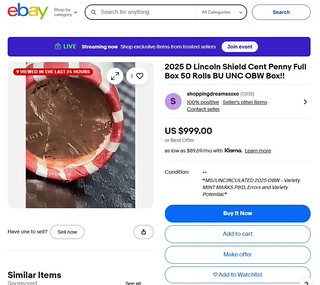 The US government's official phaseout of the penny has prompted a surge of online sales listing rolls of one-cent coins for hundreds or even thousands of dollars — but don't be fooled, an expert says.
The US government's official phaseout of the penny has prompted a surge of online sales listing rolls of one-cent coins for hundreds or even thousands of dollars — but don't be fooled, an expert says.
Inflated prices popping up on sites like eBay and Etsy are"100%" the result of opportunists exploiting public confusion about the end of the penny, John Feigenbaum, executive director of the Professional Numismatists Guild and CEO of Whitman Publishing, told The Post on Friday.
"Whenever there are stories about coins, scammers come along and take advantage of the headlines," he said.
"On Etsy, it's not unusual to see a penny that's not even worth a dollar being listed for $100,000. People try it on eBay, too. Nobody is policing what people charge."
In recent weeks, full boxes of 2025 Lincoln cents — which cost banks $25 — have been listed online for anywhere between $500 and $1,500. Some collectors have reported paying $20 for a single 50-cent roll.
Feigenbaum says those prices do not reflect the coins' real value.
He dismissed claims that 2025 pennies from Philadelphia, where the last one-cent coins were made last week, carry any special premium.
"We're probably looking at a billion coins. In 2024, they made something like 3 billion. People are tying together two different stories to make it sound like these coins are valuable."
Feigenbaum says there is only one 2025 penny product with genuine collector value — the small number of omega-marked coins the US Mint struck to commemorate the end of the denomination.
"Those coins have a special mark. They're valuable. That's everything in this situation," he said.
"Without the omega privy mark, it's a penny. With the omega, it's going to be worth $10,000 or $20,000."
To read the complete article, see:
Business
Online vendors selling pennies for $1,500 after final coins are minted: Is it a scam?
(https://nypost.com/2025/11/21/business/online-vendors-sell-pennies-for-1500-after-final-coins-are-minted-but-is-it-a-scam/)
THE LAST CANADIAN CENT
A quote often attributed to Winston Churchill is generally stated as, "You can always count on Americans to do the right thing—after they've tried everything else." Last week we struck the last U.S. cents for circulation. Canada did that thirteen years ago in 2012. There are other parallels in discussions of how the officiating officials handled the precious last coins. John Regitko wrote about the Canadian Last Cent in his column in Canadian Coin News. With permission, here's a relevant excerpt and accompanying photos. Thank you! -Editor
Although the Prime Minister can designate any Minister to be responsible for the Mint, it has been the Minister of Finance that has been given the assignment for a number of years.
My inquisitive mind wondered if one of the qualifications for the appointment to some of the top positions at the RCM is that you must be a coin collector?
I think I have a sure fire way to prove which highly placed gurus are coin collectors and which ones are not.
Pictures don't lie!
For example, during the striking of the Last Cent, the then Finance Minister, Jim Flaherty, wore a full hand glove.
And that was just to press a button on the outside of the minting press that houses the striking chamber containing the blank, as can be seen in Figure 1.
Further, after the cent was retrieved from the minting press. Flaherty held it up for a photo opportunity with his gloved hand, as can be seen in Figure 2.
These photos were taken at the Winnipeg Plant by a CBC photographer on May 4, 2012.
As can be seen, no greasy paws touched this treasure!
Conclusion: Jim Flaherty is a true coin collector!
Here are photos from the striking of the last U.S. cent. -Editor
To read the earlier E-Sylum articles, see:
THE U.S. MINTS ITS FINAL CENTS
(https://www.coinbooks.org/v28/esylum_v28n46a12.html)
MORE ON THE DEATH OF THE CENT
(https://www.coinbooks.org/v28/esylum_v28n46a13.html)
WHAT NEXT FOR THE CENTS?
Len Augsburger passed along this article from The Atlantic about the lack of plans for the cent now that they're no longer being minted for circulation. -Editor
What, exactly, is the plan for all the pennies?
Many Americans—and many people who, though not American, enjoy watching from a safe distance as predictable fiascoes unfold in this theoretical superpower from week to week—find themselves now pondering one question. What is the United States going to do with all the pennies—all the pennies in take-a-penny-leave-a-penny trays, and cash registers, and couch cushions, and the coin purses of children, and Big Gulp cups full of pennies; all the pennies that are just lying around wherever—following the abrupt announcement that the country is no longer in the penny game and will stop minting them, effective immediately?
The answer appears to be nothing at all. There is no plan.
The U.S. Mint estimates that there are 300 billion pennies in circulation—which, if true, means that the Milky Way galaxy contains about three times more American pennies than stars. How, you ask, could the plan for 300,000,000,000 coins be"nothing"? The Mint, you say, issued a formal press release about striking the final cents. Surely, you insist, that implies some sort of strategy, or at least is evidence of logical human thought and action?
Let me take your round little face between my hands and squeeze it tight as I scream this:
That's not how things work with pennies.
It is my miserable fate to possess more miscellaneous information about U.S. one-cent coins than, possibly, any other person on this planet. This is not a boast. The information I command is data no one without a neurodevelopmental disorder would ever yearn to know; it is a body of knowledge with no practical use for anyone. I contracted this condition last year, as I spent several months attempting to ascertain why, in the year 2024, one out of every two coins minted in the United States was a one-cent piece, even though virtually no one-cent pieces were ever spent in the nationwide conduction of commerce, and, on top of that, each cost more than three cents apiece to manufacture.
In search of the answer, I interviewed former directors of the Mint, members of Congress, professors of metallurgical engineering and of law, economists, charity workers, multiple manufacturers of those machines that transform regular pennies into souvenir smushed pennies, scrap-metal recyclers, historians, lobbyists, the CEO of Coinstar, coin collectors, sociologists, government auditors, and the paranoid goblins who perform the opaque work of the Federal Reserve. The initial draft of the story I filed for a popular New York City–based publication was 20,000 words long...And what I learned was that there was no sane reason why.
Mint officials told federal auditors in 2019 that, if even a fraction of the nation's never-spent pennies were simultaneously spent or cashed in, the deluge of change would be"logistically unmanageable" for the federal government. For one thing, there would likely not be enough space to store them in our nation's bank vaults.
That's the first thing I thought of when I read the news that the Mint had produced its last pennies for circulation: What are they going to do about the vaults? I went to the Mint website and read its press release. Then I read through every item on the neatly formatted Penny FAQs page. Then I realized they weren't going to do anything about the vaults, because there was no plan at all to do anything except stop making pennies.
This isn't how it usually works when a smoothly running country elects to retire some portion of its currency. Canada, unsurprisingly, provides a seemingly perfect model: When the cost to manufacture Canadian pennies reached 1.6 cents apiece, in 2012, the government announced that it would cease production of the coins and gradually withdraw them from circulation. Simultaneously, the government debuted a robust public-information campaign, explaining to Canadians the logic behind its decision and publishing guidance (including little pictures) for how to round out cash transactions in the absence of pennies. To date, the Canadian Mint has recycled more than 15,000 tons of pennies, redeemed by the public for their face value.
So what's the plan, Stan? Wayne Herndon told me that pre-1982 U.S. pennies contain a few cents worth of copper, but there's still a law on the books making it illegal to melt them. If the law were repealed, is there enough profit incentive for buyers to appear? When Giant Eagle offered to pay two cents apiece, they were mobbed with takers and suspended the program after one day. Would we hear the giant sucking sound of pennies being vacuumed out of couch cushions and piggy banks? All I know for sure is that if people start taking these to their banks and the banks start refusing them, a lot of people are going to be upset and will maybe start throwing pennies at their Congresspeople at their next Town Hall. And those aren't aluminum Mardi gras doubloons, so prepare to duck fast. -Editor
To read the complete article, see:
Pennies Are Trash Now
(https://www.theatlantic.com/ideas/2025/11/pennies-circulation-mint/684935/)
UNCANCELLED MARTHA WASHINGTON PATTERN DIES
Mike Byers published an article about a unique pair of uncancelled proof Martha Washington Half Dollar Experimental Test Piece dies. Excerpted here with permission. Thank you. -Editor
Used to Strike Half Dollar Experimental Test Pieces
for U.S. Judd #2131-2143
This is the only known set of PROOF Uncancelled Martha Washington Half Dollar-sized dies in private hands. Martha Washington dies have become the U.S. Mint's all-purpose design for testing new compositions, surfaces and planchet sizes. These experimental strikings were conducted both inside the Mint and outside by companies contracted by the U.S. Mint. Companies within the United States included IDX Inc, PMX Industries, and Olin Brass Corporation while Schuler AG in Germany struck coins overseas. Schuler AG is the supplier of Schuler coin presses to the United States Mint to strike our coinage.
These PROOF Uncancelled Martha Washington Half Dollar-sized dies are featured on the cover of Mint Error News Magazine Issue #86. There are only two other Martha Washington Half Dollar-Sized Uncancelled Dies known in private hands, and those struck mint state test pieces. The first one discovered was featured both in Coin Week and on the cover of Mint Error News Magazine Issue #44 (Spring 2018).
Martha Washington dies have "fantasy designs" intended to avoid creating rarities with regular coinage motifs. The design of these proof dies was used by the U.S. Mint for metallurgical testing beginning in 1965 until 2011 when the dies were redesigned. The obverse features a bust of Martha Washington, with the inscription "VIRGINIA" above and the date "1759" (the year she married George Washington) below. The reverse typically features an image of Mount Vernon. These Martha Washington proof dies and test pieces are featured in the U.S. Patterns website (uspatterns.com).
This unique set of PROOF Uncancelled Martha Washington Half Dollar-sized dies belong in a premier collection of U.S. patterns or unique numismatic treasures. These dies are part of the U.S. Mint's history of experimenting and striking pattern coins prior to producing our nation's coins for circulation. The story of the Martha Washington dies and test strikes, as it unfolds, is one of the most interesting numismatic developments in decades.
To read the complete article, see:
Unique Pair of PROOF Uncancelled
Martha Washington Dies
(https://minterrornews.com/discoveries-11-12-25-unique-pair-of-proof-uncancelled-martha-washington-dies.html)
ALTHEA GIBSON'S LEGACY
The Smithsonian published the following article in their blog about the legacy of multi-sport athlete Althea Gibson, who is honored as part of the American Women Quarters Program. -Garrett
Trailblazing multi-sport athlete Althea Gibson (1927–2003) broke barriers as the first Black woman to compete at Wimbledon and win Grand Slam titles. She ended her career with 11 Grand Slam titles, including two U.S. National Championships (now U.S. Open). She is the twentieth and final woman honored as part of the American Women Quarters Program, our partnership with the U.S. Mint. In celebration for the quarter's release, staff writer Meredith Herndon interviewed Don Felder, Althea's second cousin, for an inside perspective on Althea's influence within her own family and the bittersweet contrast between the treatment Althea received while competing and the public recognition she is receiving after her passing.
Could you share what Althea Gibson was like as a member of your family — beyond her public achievements?
Althea's mother and my grandfather were brother and sister. Growing up together in New York, our families were very close. My mother and Althea's mother were extremely close, and we were always at her house. Althea was traveling extensively, so she was rarely home when we would visit outside of the holidays, but she was very family oriented.
I inherited many of her personal effects after her passing, and I found a list of all the family members with their birthdays. Everyone would get cards on their birthdays. She really kept in touch and sent so many letters—lots of letters—not just to the family but to friends and other athletes. I have telegrams between Althea and Alex Haley (author of Roots: The Saga of an American Family), and letters of support and encouragement to Venus [Williams] when she first played at Wimbledon [in 1997].
She always tried to be a mentor—it was very important to her. When she was home in New York, she'd come to our school as a guest speaker. She'd show up in her Wightman blazer and bring us up on stage with her. That's how everyone in junior high and high school knew me as Althea's cousin. We were so proud to have a family member that was in that league and that caliber.

Althea Gibson (USA) holds the Ladies' Singles trophy on Centre Court after winning the title against Angela Mortimer at The Championships in 1958. Held at The All England Lawn Tennis Club, Wimbledon. Credit: AELTC/Arthur Cole.
Althea not only changed tennis but also paved the way for future generations of women and athletes of color. Players like Coco Gauff, Naomi Osaka, and Venus and Serena Williams have all cited her as a major source of inspiration. The 2025 US Open theme was"75 Years of Breaking Barriers" in honor of Althea becoming the first Black player in a tournament 75 years ago. If Althea could see this recognition today, what do you imagine her response might be?
I think Althea would be very, very proud, honored, and humbled. She mentioned to a nephew that she knew she would not receive just recognition while she was alive. And that's exactly what's happening at the U.S. Open and now the new quarter.
I find it a bit ironic that she's being honored on a quarter when she didn't make a lot of money playing tennis. In fact, there were many times that she toured and was not paid at all. Friends like Joe Louis and Sugar Ray Robinson actually donated and gave her money for travel and hotels because she didn't make any money.
In the end, her financial situation really got to her. She'd watch these tennis games and hear that there's a $1 million pot, and it was bittersweet for her. There were tennis clubs where she played and she couldn't get in the front door, couldn't use the locker room, and had to change in her car. She had it tough, but she was thick-skinned. I think she dismissed a lot of it—she had to. And if she could see it all now, I know she would be so proud and honored.
When you first saw the design of the Althea Gibson quarter, what was your reaction?
I was involved in the design process and actually submitted photos to the U.S. Mint. Together with the rest of the family, we selected about 13 images and sent them to the Mint. When the design was released and we saw which one was used, we were thrilled. It is perfect. It really captures her and is so similar to the photo.
As a coin collector, you know the importance of coins in telling America's story. What does it mean to you to see Althea's story preserved and shared through this quarter?
 Every coin tells a story. To see all the women in the American Women Quarters Program, including Althea, recognized in such a public way—it's a big a reflection of American history and what we're trying to talk about in it. To honor these women who maybe didn't get much recognition in their lifetime, to tell their story and get their names out there. I know that, more and more, people are moving away from currency and coins and using their phones. But, as a coin collector since childhood, I see how important it is and feel what an honor it is.
Every coin tells a story. To see all the women in the American Women Quarters Program, including Althea, recognized in such a public way—it's a big a reflection of American history and what we're trying to talk about in it. To honor these women who maybe didn't get much recognition in their lifetime, to tell their story and get their names out there. I know that, more and more, people are moving away from currency and coins and using their phones. But, as a coin collector since childhood, I see how important it is and feel what an honor it is.
I said to my sister,"Can you imagine we go into a store now and get change with our family member on the coin?" It's quite exciting!
Beyond her athletic achievements, Althea often spoke about the importance of education. How do you see that part of her legacy?
In East Orange, New Jersey, there's a primary school named after Althea, the Althea Gibson Academy. Education and mentorship were so important to her, and to see a school full of children who know who she is and what she stood for—it's just amazing. Someone from the Althea Gibson estate will go speak at the school on occasion, and I'm sure we will do an event with them celebrating the quarter release. It will add an even higher regard for the name of the school they're attending and their connection with her.
Is there anything you'd like to share about Althea that you feel people don't always know or recognize?
Althea was appointed as the first African American sports ambassador by the U.S. government in the 1960s—during a time of high racial tension. She traveled the world and represented African American athletes on a global stage, but when she came home, she'd get nasty letters and be called names. I think if she could see it all today, she'd be overwhelmed. She'd be honored. It's a shame she couldn't experience this in her lifetime, but I think she's out there smiling upon us, very pleased.
To read the complete article, see:
Every Coin Tells a Story: Althea Gibson's Family Reflects on Her Legacy
(womenshistory.si.edu/blog/every-coin-tells-story-althea-gibsons-family-reflects-her-legacy)
WWII SPECIMEN UKRAINIAN NOTES
Ukraine has been in the news for four years as it has endured attacks by Russia. As prime centrally-located European real estate, it's been the subject of invasions for centuries. This article by Stack's Bowers Director of Consignments & Senior Numismatist Dennis Hengeveld highlights banknotes connected to the WWII struggles for Ukraine. -Editor
Over the past several years, Stack's Bowers Galleries has been selling the Al Kugel Collection of World Paper Money. Mr. Kugel was a well-known collector who built advanced collections of stamps and paper money, with a focus on items from Eastern Europe and World War II. His collection of paper money is among the most exciting cabinets to have come to the market in this century, and many notes set record prices. With the end of the collection in sight, it is time for one more article focused on our offering of a set of notes from Ukraine in the January 2026 NYINC World Paper Money auction. It is sure to attract much interest from specialized collectors, and it will surely be seen as one of the highlights of this now famous collection.
Offered in individual lots, will be a complete set of specimens from the Emission Bank of Ukraine, prepared by the German army and perhaps intended for use by the occupying force. Three notes are denominated in Rubles, while four are denominated in Chervontsiv (1 Chervontsiv being equal to 10 Rubles). The notes have a fairly simplistic design, but are heralded as great rarities. Very few ‘issued' notes (meaning fully printed with serial numbers, as they were never issued into circulation) have appeared in the marketplace. We did previously sell a 5 Chervontsiv (arguably the only denomination that sometimes becomes available) from the Al Kugel Collection, which brought $24,000 in our Fall 2025 Maastricht Showcase Auction.
Operation Barbarossa began on June 22, 1941, which saw 3.8 million personnel of the Axis powers invade the Soviet Union (the most significant invasion force in the history of warfare). The Soviet Red Army was suffering internally at the time due to the Great Purge of the officer corps by Stalin, most of whom were executed or imprisoned. Initial advances by the Axis invaders were immense, swallowing up large swaths of land and taking many prisoners. The advance was eventually halted in December 1941, when the Red Army regrouped and launched counteroffensives. Much of Ukraine was occupied from 1941 until October 1944. The warfare in Ukraine was brutal (much like the rest of the Eastern Front), with many atrocities and war crimes committed by the Nazis. This series of notes was never issued after the Germans decided not to use the Russian language on the notes. Instead, during the occupation, the Zentralnotenbank Ukraine issued notes in German, which are much easier to acquire.
Each note in the set featured in our official auction of the NYINC is a specimen produced in Germany, with official annotations and a ‘DRUCKPROBE' (printer's sample) perforation. They are fresh, bright, and certainly among the highlights of the extensive Al Kugel Collection. According to the German Rosenberg catalog, the set is unique, having originally come from the specimen collection of the German government printer. In addition to this, there are two other notes from this series that will be featured in the sale, a 1 Ruble and a 1 Chervontsiv with regular serial numbers, both extreme rarities. We are aware of a single previous sale of the 1 Ruble in ‘issued' format – in 2013 one brought $35,000 in a European auction. To the best of our knowledge, it might be the first time that the 1 Chervontsiv appears at public auction in this format, putting a fitting end to the sale of the Al Kugel Collection. Look for the sale to be posted on our website in the latter half of December. The auction will take place in conjunction with the New York International Numismatic Convention in the middle of January of 2026.
To read the complete article, see:
Coming Soon: An Extremely Rare Set of Unissued Ukrainian Notes
(https://stacksbowers.com/coming-soon-an-extremely-rare-set-of-unissued-ukrainian-notes/)
VIETNAMESE CURRENCY EXHIBIT
My friend Howard Daniel would have enjoyed this exhibit of Vietnamese Currency in Ho Chi Minh City. -Editor
This morning, the exhibition"Vietnamese Currency – A Journey Along the Flow of National History" officially opened at the State Bank of Vietnam (SBV) Branch Region 2 at 8 Vo Van Kiet Street in Ho Chi Minh City's Saigon Ward.
Attending the opening ceremony were Governor of the SBV Vietnam Nguyen Thi Hong, Deputy Secretary of the Ho Chi Minh City Party Committee Van Thi Bach Tuyet, Vice Chairman of the Ho Chi Minh City People's Committee Nguyen Van Dung, along with former leaders of the SBV from various periods.
Organized by SBV Branch Region 2, the event aims to introduce to the public representative artifacts of Vietnamese currency across different historical stages, closely tied to the nation's development.
The exhibition showcases more than 1,500 artifacts dating from 1875 to the present, including Indochina banknotes, Cu Ho (old Ho Chi Minh) banknotes, resistance currency, treasury notes, ration coupons, coins, and polymer banknotes. Each coin and banknote reflects images of the country, its people, culture, and spirit, collectively forming a broad narrative of the nation's historical journey — the history of a resilient, modest, yet proud Vietnam.
 Within the framework of the exhibition, in addition to stories about the history of Vietnamese currency through different eras, visitors are also introduced to the traditional banking space and the digitized Ho Chi Minh cultural space. Through interactive screens, the public has the opportunity to gain deeper insight into the history of the formation and development of Vietnam's banking system, along with valuable lessons on the ideology, ethics, and lifestyle of President Ho Chi Minh.
Within the framework of the exhibition, in addition to stories about the history of Vietnamese currency through different eras, visitors are also introduced to the traditional banking space and the digitized Ho Chi Minh cultural space. Through interactive screens, the public has the opportunity to gain deeper insight into the history of the formation and development of Vietnam's banking system, along with valuable lessons on the ideology, ethics, and lifestyle of President Ho Chi Minh.
The exhibition is held on the ground floor of the SBV Branch Region 2 headquarters, at 8 Vo Van Kiet Street. It is open free of charge on weekends from November 22, 2025, until the end of April 2026, for visitors aged 14 and above.
To read the complete article, see:
1,500 Vietnamese currency artifacts exhibited in Ho Chi Minh City
(https://en.sggp.org.vn/1500-vietnamese-currency-artifacts-exhibited-in-ho-chi-minh-city-post121956.html)
LOOSE CHANGE: NOVEMBER 23, 2025
Here are some additional items in the media this week that may be of interest. -Editor
Museum thefts continue - here's the latest report from Lausanne, Switzerland. -Editor
Authorities in Switzerland are searching for two robbers who overpowered a security guard at a Roman-era museum in Lausanne, smashed a display case and made off with dozens of gold coins that had been displayed inside.
City police said that the suspects had purchased tickets and waited until other visitors had left shortly before closing time, before assaulting and restraining the guard and then breaking the display case.
The monetary value of the coins stolen in the heist Tuesday was not immediately revealed, but police said they had "archaeological value."
The theft comes at a time when gold prices have soared in global markets and a high-profile robbery of jewels at the Louvre in Paris exposed vulnerabilities and security lapses at museums.
We spent a day in Lausanne on our Switzerland trip last year, but didn't visit any museums. The report doesn't name the museum or describe the missing coins. It's also not clear (to me, anyway) if the image accompanying the article is of the display case in question or just a stock photo. What is clear is that this epidemic of thefts continues. -Editor
To read the complete article, see:
Robbers overpower guard and steal dozens of ancient gold coins from Swiss museum
(https://www.euronews.com/2025/11/21/robbers-overpower-guard-and-steal-dozens-of-ancient-gold-coins-from-swiss-museum)
Mexicans Hoarding 50 Peso Axolotl Notes
For most of her life, Gorda was just an axolotl who lived in a museum in Mexico City – that is, until she became the star of the country's favourite banknote.
 The note, which features a depiction of Gorda as the model for Mexico's iconic species of salamander, went into circulation in 2021, dazzling the judges of the International Bank Notes Society, who declared it the Note of the Year.
The note, which features a depiction of Gorda as the model for Mexico's iconic species of salamander, went into circulation in 2021, dazzling the judges of the International Bank Notes Society, who declared it the Note of the Year.
Four years later, the Bank of Mexico has released a report revealing that 12.9 million Mexicans are holding on to this note as if it were worth more than just its value of 50 pesos, or a little under $3. Indeed, millions of them are hoarding more than one.
Only a minority said they would not contemplate spending the notes. Nonetheless, the survey found that roughly $150m worth of them were at least temporarily out of circulation at the time. Some of the first to be printed are even being traded for 100 times their intended value.
To read the complete article, see:
A lot of axolotls: the amphibian-themed banknote Mexicans don't want to spend
(https://www.theguardian.com/world/2025/nov/21/axolotl-banknote-mexico-amphibian)
While not numismatic, this story should resonate with all collectors, particularly those whose knowledge and love of a field stretches far beyond their modest means. -Editor
Dorothy Vogel, a librarian who, with her postal-clerk husband, Herbert, bought thousands of works from future art stars like Sol LeWitt and Donald Judd, stashing them in their cramped one-bedroom New York apartment and eventually handing over the entire collection to the National Gallery of Art without ever turning a profit, died on Nov. 10 in Manhattan. She was 90.
Her death, in a hospital, was confirmed by Kathryn Obler, a cousin. Ms. Vogel left no immediate survivors.
That the Vogels, who were modest in dress and bearing, would come to take their place as benefactors alongside Rockefellers and Mellons was every bit as unlikely as it was that some of the works they collected — like the tiny snippet of frayed rope by the Post-Minimalist artist Richard Tuttle — would land in one of the world's premier art museums, alongside Vermeers and Van Goghs.
Throughout their decades as collectors, Ms. Vogel worked at the Brooklyn Public Library as a reference librarian, and Mr. Vogel, a high school dropout from Harlem, did the night shift at a post office sorting mail.
Their rent-controlled apartment on Manhattan's Upper East Side functioned as a fine-art storage locker as well as an exhibition space. Stacked on the floor and crammed into closets were some 4,000 works by luminaries like the Pop artist Roy Lichtenstein; the photographers Cindy Sherman and Lorna Simpson; the German sculptor and performance artist Joseph Beuys; the Minimalist Robert Mangold; and the video art pioneer Nam June Paik.
While works by the artists the Vogels favored often sell for hundreds of thousands of dollars, or even millions, their collection was quite literally priceless, in the sense that none of it ever went to market."I didn't make a $20 bill outright on any artist," Herbert Vogel, who died in 2012, told"60 Minutes" in 1995.
To read the complete article, see:
Dorothy Vogel, Librarian With a Vast Art Collection, Dies at 90
(https://www.nytimes.com/2025/11/22/arts/dorothy-vogel-dead.html)
To read the earlier E-Sylum article, see:
MODERN ART COLLECTOR HERBERT VOGEL, 1922-2012
(https://coinbooks.org/esylum_v15n32a15.html)
ABOUT THIS ISSUE: NOVEMBER 23, 2025
My diary article tells all about my Tuesday evening. Thursday our daughter Hannah came home from college for the holiday break, and Friday night her and my wife went to see the Wicked: For Good movie. Being back at the office fulltime I didn't get to really dive into working on The E-Sylum until the weekend. But Garrett was working hard (and smart), using some automation to help create a number of articles. Thanks! And speaking of thanks, here's hoping our U.S. readers have great Thanksgiving. This image is from the American Numismatic Association Money Museum Society of Medalists virtual exhibit. Check it out at https://www.money.org/money-museum/virtual-exhibits-mia-case20/ .
Finally, here are some interesting non-numismatic articles I came across this week.
Thousands of rare American recordings — some 100 years old — go online for all to enjoy
(https://laist.com/news/arts-and-entertainment/thousands-of-rare-american-recordings-go-online-for-all-to-enjoy)
How the Internet Rewired Work—and What That Tells Us About AI's Likely Impact
(https://www.wsj.com/tech/ai/internet-work-ai-9c42127d)
Cardea or Carda was the ancient Roman goddess of the hinge
(https://en.wikipedia.org/wiki/Cardea#Cardea_and_doorways)
Man Who Stuffed Parakeets in His Pants Faces Smuggling Charges
(https://www.nytimes.com/2025/11/15/us/parakeets-smuggling-in-pants.html)
-Editor
Wayne Homren
Wayne Homren is the founding editor of The E-Sylum and a consultant for the Newman Numismatic Portal. His collecting interests at various times included U.S. Encased Postage Stamps, merchant counterstamps, Pittsburgh Obsolete paper money, Civil War tokens and scrip, Carnegie Hero Medals, charge coins and numismatic literature. He also collects and has given presentations on the work of Money Artist J.S.G. Boggs. In the non-numismatic world he's worked in artificial intelligence, data science, and as a Program Manager for the U.S. Department of Defense.
Garrett Ziss
Garrett Ziss is a numismatic collector and researcher, with a focus on American paper money and early U.S. silver and copper coins. He is also a part-time U.S. coin cataloger for Heritage Auctions. Garrett assists Editor Wayne Homren by editing and formatting a selection of articles and images each week. When he's not engaged in numismatics, Garrett is pursuing a Master's Degree in Quantitative Economics at the University of Pittsburgh.
Pete Smith
Numismatic researcher and author Pete Smith of Minnesota has written about early American coppers, Vermont coinage, numismatic literature, tokens and medals, the history of the U.S. Mint and much more. Author of American Numismatic Biographies, he contributes original articles to The E-Sylum often highlighting interesting figures in American numismatic history.
Greg Bennick
Greg Bennick (www.gregbennick.com) is a keynote speaker and long time coin collector with a focus on major mint error coins and US counterstamps. He is on the board of both CONECA and TAMS and enjoys having in-depth conversations with prominent numismatists from all areas of the hobby. Have ideas for other interviewees? Contact him anytime on the web or via instagram
@minterrors.
John Nebel
Numismatist, photographer, and ANS Board member and Fellow John Nebel of Boulder, CO helped the ANA and other clubs like NBS get online in the early days of the internet, hosting websites gratis through his Computer Systems Design Co. To this day he hosts some 50 ANA member club sites along with our
coinbooks.org site, making the club and our E-Sylum archive available to collectors and researchers worldwide.
Bruce Perdue
Encased coinage collector (encasedcoins.info) Bruce Perdue of Aurora, Illinois has been the volunteer NBS webmaster from its early days and works each week to add the latest E-Sylum issue to our archive and send out the email announcement.

